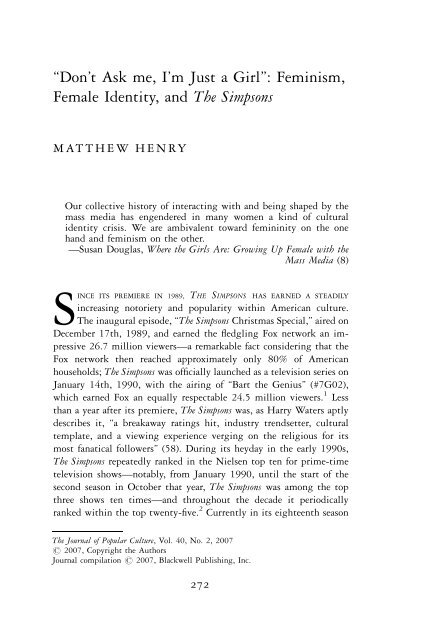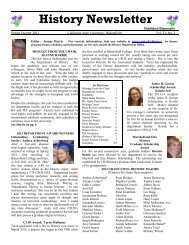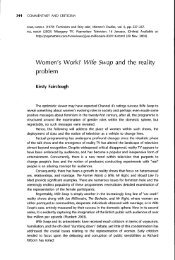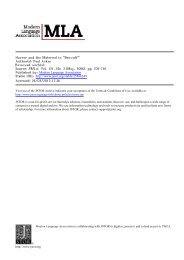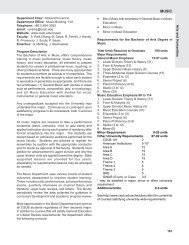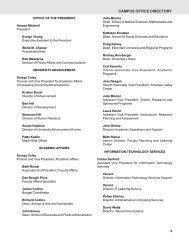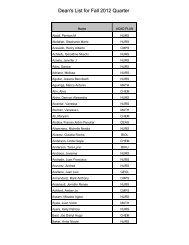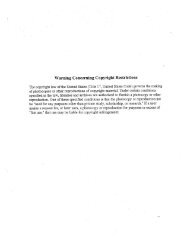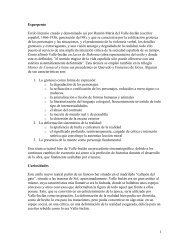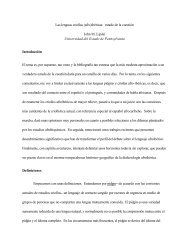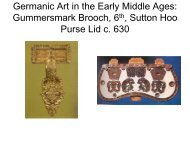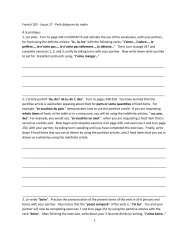''Don't Ask me, I'm Just a Girl'': Feminism, Female Identity, and The ...
''Don't Ask me, I'm Just a Girl'': Feminism, Female Identity, and The ...
''Don't Ask me, I'm Just a Girl'': Feminism, Female Identity, and The ...
Create successful ePaper yourself
Turn your PDF publications into a flip-book with our unique Google optimized e-Paper software.
‘‘Don’t <strong>Ask</strong> <strong>me</strong>, I’m <strong>Just</strong> a Girl’’: <strong>Feminism</strong>,<br />
<strong>Female</strong> <strong>Identity</strong>, <strong>and</strong> <strong>The</strong> Simpsons<br />
MATTHEW HENRY<br />
Our collective history of interacting with <strong>and</strong> being shaped by the<br />
mass <strong>me</strong>dia has engendered in many wo<strong>me</strong>n a kind of cultural<br />
identity crisis. We are ambivalent toward femininity on the one<br />
h<strong>and</strong> <strong>and</strong> feminism on the other.<br />
—Susan Douglas, Where the Girls Are: Growing Up <strong>Female</strong> with the<br />
Mass Media (8)<br />
SINCE ITS PREMIERE IN 1989, THE SIMPSONS HAS EARNED A STEADILY<br />
increasing notoriety <strong>and</strong> popularity within A<strong>me</strong>rican culture.<br />
<strong>The</strong> inaugural episode, ‘‘<strong>The</strong> Simpsons Christmas Special,’’ aired on<br />
December 17th, 1989, <strong>and</strong> earned the fledgling Fox network an impressive<br />
26.7 million viewers—a remarkable fact considering that the<br />
Fox network then reached approximately only 80% of A<strong>me</strong>rican<br />
households; <strong>The</strong> Simpsons was officially launched as a television series on<br />
January 14th, 1990, with the airing of ‘‘Bart the Genius’’ (#7G02),<br />
which earned Fox an equally respectable 24.5 million viewers. 1 Less<br />
than a year after its premiere, <strong>The</strong> Simpsons was, as Harry Waters aptly<br />
describes it, ‘‘a breakaway ratings hit, industry trendsetter, cultural<br />
template, <strong>and</strong> a viewing experience verging on the religious for its<br />
most fanatical followers’’ (58). During its heyday in the early 1990s,<br />
<strong>The</strong> Simpsons repeatedly ranked in the Nielsen top ten for pri<strong>me</strong>-ti<strong>me</strong><br />
television shows—notably, from January 1990, until the start of the<br />
second season in October that year, <strong>The</strong> Simpsons was among the top<br />
three shows ten ti<strong>me</strong>s—<strong>and</strong> throughout the decade it periodically<br />
ranked within the top twenty-five. 2 Currently in its eighteenth season<br />
<strong>The</strong> Journal of Popular Culture, Vol. 40, No. 2, 2007<br />
r 2007, Copyright the Authors<br />
Journal compilation r 2007, Blackwell Publishing, Inc.<br />
272
Don’t <strong>Ask</strong> <strong>me</strong>, I’m <strong>Just</strong> a Girl 273<br />
on the Fox Television Network, <strong>The</strong> Simpsons now has the distinction of<br />
being the longest-running pri<strong>me</strong>-ti<strong>me</strong> animated show as well as the<br />
longest-running pri<strong>me</strong>-ti<strong>me</strong> situation co<strong>me</strong>dy in television history,<br />
surpassing the current record holder, <strong>The</strong> Adventures of Ozzie <strong>and</strong> Harriet,<br />
which ran for fourteen seasons. Quite simply, <strong>The</strong> Simpsons is today<br />
one of the most recognizable <strong>and</strong> celebrated icons of A<strong>me</strong>rican popular<br />
culture <strong>and</strong> clearly a bona fide cultural pheno<strong>me</strong>non. 3<br />
<strong>The</strong> intention here, however, is not to explain the popularity of <strong>The</strong><br />
Simpsons but instead to examine the ideological implications of such<br />
enormous popularity <strong>and</strong> broad reach—in short, to explore the show’s<br />
engage<strong>me</strong>nt with <strong>and</strong> influence upon highly politicized issues in contemporary<br />
A<strong>me</strong>rican culture. 4 For these purposes, the most salient<br />
point is that <strong>The</strong> Simpsons is above all a sophisticated satire on A<strong>me</strong>rican<br />
culture. Although its satirical edge has waned so<strong>me</strong>what in recent<br />
years, it continues to function in this capacity week after week, offering<br />
scathing critiques of A<strong>me</strong>rica’s nu<strong>me</strong>rous faults <strong>and</strong> flaws. Among<br />
other things, <strong>The</strong> Simpsons <strong>me</strong>rcilessly exposes the hypocrisy <strong>and</strong> ineptitude<br />
of pop psychology, corporate greed, com<strong>me</strong>rcialism, consu<strong>me</strong>rism,<br />
<strong>and</strong> modern child-rearing, as well as the potential dangers of<br />
funda<strong>me</strong>ntal religion, homophobia, racism, <strong>and</strong> sexism. Importantly,<br />
<strong>The</strong> Simpsons most commonly offers its satire from a leftist political<br />
position, <strong>and</strong> it works from this position to lambaste, among other<br />
things, the universality <strong>and</strong> normativity of so-called ‘‘traditional family<br />
values’’ <strong>and</strong> to satirize A<strong>me</strong>rica’s exclusionary practices. In particular,<br />
the show repeatedly critiques the treat<strong>me</strong>nt of various so-called minorities<br />
in A<strong>me</strong>rican culture, notably those whose status is based on<br />
religion, race, age, sex, <strong>and</strong> gender.<br />
<strong>The</strong>se points provide a context for an examination of feminism on<br />
<strong>The</strong> Simpsons, an ele<strong>me</strong>nt of the show that has not yet received due<br />
critical attention. This essay specifically explores the representation of<br />
wo<strong>me</strong>n on <strong>The</strong> Simpsons <strong>and</strong> explores how the show engages the politics<br />
of feminist move<strong>me</strong>nt <strong>and</strong> articulates a feminist sensibility within<br />
its satire. <strong>The</strong> Simpsons’s engage<strong>me</strong>nt with feminism is not simple,<br />
however, as the show both reflects <strong>and</strong> reflects upon the ideological<br />
preoccupations of the culture, which are invariably complex. Underst<strong>and</strong>ings<br />
of feminism in popular culture are imbued with a great deal<br />
of confusion <strong>and</strong> contradiction, a fact made quite evident by the current<br />
proliferation of ‘‘girl power’’ rhetoric <strong>and</strong> the varied articulations<br />
of female ‘‘empower<strong>me</strong>nt.’’ Indeed, as Am<strong>and</strong>a Lotz notes, in the new
274 Matthew Henry<br />
millennium there is a vast theoretical confusion over what one even<br />
<strong>me</strong>ans when invoking the term ‘‘feminism.’’ 5 As a result of the real<br />
changes in wo<strong>me</strong>n’s lives <strong>and</strong> the shifts in theoretical perspectives since<br />
the height of second-wave feminism, many wo<strong>me</strong>n’s lives today are<br />
marked by ambivalence <strong>and</strong> ambiguity, complexity <strong>and</strong> contradiction.<br />
This state of affairs has been com<strong>me</strong>nted upon by a host of contemporary<br />
writers, both mainstream <strong>and</strong> academic, including Susan Faludi,<br />
Naomi Wolf, Susan Douglas, Joanne Hollows, Bonnie Dow, Lauren<br />
Rabinovitz, Am<strong>and</strong>a Lotz, Ellen Riordan, <strong>and</strong> Katha Pollit. In ‘‘<strong>Feminism</strong><br />
at the Millennium,’’ the introduction to her collection of essays<br />
entitled Subject to Debate: Sense <strong>and</strong> Dissents on Wo<strong>me</strong>n, Politics, <strong>and</strong> Culture,<br />
Katha Pollit flatly states that ‘‘[an] ambivalence marks even the<br />
attempt to evaluate how powerful wo<strong>me</strong>n are’’ (xvi). In Where the Girls<br />
Are: Growing Up <strong>Female</strong> with the Mass Media, Susan Douglas similarly<br />
claims that ‘‘A<strong>me</strong>rican wo<strong>me</strong>n today are a bundle of contradictions’’<br />
(9). As Douglas admirably demonstrates, much of this confusion about<br />
wo<strong>me</strong>n’s ‘‘proper place’’ <strong>and</strong> roles in the culture derives from the mixed<br />
<strong>me</strong>ssages to be found in mainstream mass <strong>me</strong>dia. As a result, many<br />
wo<strong>me</strong>n today seem to be in a conflicted state, torn between very traditional<br />
<strong>and</strong> stereotypical ideas about who <strong>and</strong> what they ought to be<br />
<strong>and</strong> rather progressive <strong>and</strong> liberating concepts of who <strong>and</strong> what they<br />
can be. As Douglas succinctly puts it, ‘‘<strong>The</strong> war that has been raging in<br />
the <strong>me</strong>dia is not a simplistic war against wo<strong>me</strong>n but a complex struggle<br />
between feminism <strong>and</strong> antifeminism that has reflected, reinforced,<br />
<strong>and</strong> exaggerated our culture’s ambivalence about wo<strong>me</strong>n’s roles for over<br />
thirty-five years’’ (12 – 13).<br />
Given <strong>The</strong> Simpsons’s regular engage<strong>me</strong>nt with contemporary issues<br />
<strong>and</strong> its reflection of A<strong>me</strong>rican cultural values, it is not surprising that<br />
much of the ambivalence <strong>and</strong> ambiguity that currently surround female<br />
identity is often reflected in characterizations <strong>and</strong> storylines on<br />
the show. What <strong>The</strong> Simpsons offers its viewers is a complex blend of<br />
progressive <strong>and</strong> traditional attitudes toward female identity <strong>and</strong> feminist<br />
move<strong>me</strong>nt. Of course, such conflicting ideologies <strong>and</strong> representations<br />
seem in perfect keeping with the ti<strong>me</strong>s in which <strong>The</strong> Simpsons<br />
appeared, for the 1990s itself was an era of great ambiguity about<br />
wo<strong>me</strong>n’s lives <strong>and</strong> widespread confusion over gender norms. By way of<br />
example, witness: the challenges to the male-only policies of colleges<br />
such as the Citadel <strong>and</strong> the Virginia Military Institute; the evolution of<br />
<strong>and</strong> debates over ‘‘third-wave’’ feminism, particularly in relation to the
Don’t <strong>Ask</strong> <strong>me</strong>, I’m <strong>Just</strong> a Girl 275<br />
rise (<strong>and</strong> subsequent commodification) of ‘‘girl power’’ rhetoric; the<br />
judicial re-evaluations of Title IX legislation <strong>and</strong> the establish<strong>me</strong>nt of<br />
professional wo<strong>me</strong>n’s sports teams <strong>and</strong> leagues; <strong>and</strong> the conflicted representations<br />
of wo<strong>me</strong>n in cultural pheno<strong>me</strong>na as varied as music (e.g.,<br />
Madonna, <strong>The</strong> Lilith Fair, <strong>The</strong> Spice Girls), television (e.g., Murphy<br />
Brown, Roseanne, Ally McBeal, Buffy the Vampire Slayer), <strong>and</strong> film (e.g.,<br />
<strong>The</strong>lma <strong>and</strong> Louise, G.I. Jane, <strong>The</strong> Long Kiss Goodnight). <strong>The</strong>se complexities<br />
<strong>and</strong> ambiguities are also apparent on <strong>The</strong> Simpsons when one focuses<br />
on the show’s construction of gender roles, both male <strong>and</strong> female, as<br />
well as its incorporation of ideological norms regarding gender in<br />
A<strong>me</strong>rican culture. A full analysis of the issues attendant on feminism<br />
<strong>and</strong> female identity in popular culture <strong>and</strong> on <strong>The</strong> Simpsons is beyond the<br />
scope of this paper; therefore, this examination of <strong>The</strong> Simpsons concentrates<br />
specifically on three of the show’s primary female characters:<br />
Marge Simpson, Selma Bouvier (Marge’s sister), <strong>and</strong> Lisa Simpson.<br />
‘‘Family Values’’ <strong>and</strong> Gender Norms<br />
<strong>The</strong> initial success of <strong>The</strong> Simpsons was due mainly to the willful manipulation<br />
of the image of Bart Simpson: the show capitalized upon the<br />
archetype of the male adolescent rebel <strong>and</strong> upon the rapid commodification<br />
of easily reproducible phrases such as ‘‘Don’t have a cow, man,’’<br />
‘‘Eat my shorts,’’ <strong>and</strong> ‘‘Ay, caramba!’’ However, from the very start, <strong>The</strong><br />
Simpsons was concerned with adult the<strong>me</strong>s <strong>and</strong> with issues relevant to<br />
both <strong>me</strong>n <strong>and</strong> wo<strong>me</strong>n concerning the relationships they have with one<br />
another <strong>and</strong> with <strong>me</strong>mbers of their im<strong>me</strong>diate families. As is well<br />
known, <strong>The</strong> Simpsons is foremost a satire upon the idealized images of<br />
family life depicted by both traditional <strong>and</strong> contemporary do<strong>me</strong>stic<br />
sitcoms. Though the Simpson family is far from the <strong>me</strong>dia-constructed<br />
norm offered by television shows such as Leave It to Beaver or Father<br />
Knows Best in the 1950s or <strong>The</strong> Cosby Show <strong>and</strong> Family Ties in the 1980s,<br />
they are perhaps closer to the actual norm, a distinction well displayed<br />
in the debate over ‘‘family values’’ in the early 1990s. In a speech given<br />
at the annual convention of the National Religious Broadcasters in<br />
1992, George Bush, Sr. infamously stated that: ‘‘We need a nation<br />
closer to <strong>The</strong> Waltons than <strong>The</strong> Simpsons.’’ 6 Bush’s com<strong>me</strong>nt was a la<strong>me</strong>nt<br />
for the loss of a supposedly better <strong>and</strong> more stable past <strong>and</strong><br />
concept of family, perhaps best epitomized by the nuclear family of the
276 Matthew Henry<br />
1950s <strong>and</strong> the paintings of Norman Rockwell. What Bush failed to see<br />
is that these were only idealized images of family <strong>and</strong> community, only<br />
<strong>me</strong>dia-constructed realities. <strong>The</strong> Simpsons are quite simply more akin to<br />
what we are today <strong>and</strong> more attuned to the realities of contemporary<br />
life. Nonetheless, ‘‘family values’’ is a concept that has had increasingly<br />
strong cultural purchase over the last decade. Not surprisingly, the<br />
conservative attitude expressed by George Bush, Sr. returned full force<br />
in the 1996 presidential election, with Bush’s senti<strong>me</strong>nts strongly<br />
echoed by Bob Dole, <strong>and</strong> then again in the 2000 presidential ‘‘selection,’’<br />
reiterated this ti<strong>me</strong> in the words of George Bush, Jr. <strong>The</strong> consistent<br />
the<strong>me</strong> of the conservative political rallying cry was for a return<br />
to ‘‘traditional family values’’—<strong>me</strong>aning, it see<strong>me</strong>d, to bourgeois<br />
values, compulsory heterosexuality, male dominance, <strong>and</strong> female submission—<strong>and</strong><br />
for an increased presence of such values in mainstream<br />
popular art forms such as film <strong>and</strong> television.<br />
From the very start, <strong>The</strong> Simpsons has engaged with the political hot<br />
topic of ‘‘family values’’ in nu<strong>me</strong>rous ways—most obviously in the<br />
relationships between the Simpson parents <strong>and</strong> children, but also quite<br />
notably in the relationship between Ho<strong>me</strong>r <strong>and</strong> Marge. For example, in<br />
the first season, the show featured two episodes (interestingly aired<br />
back-to-back) that dealt openly with infidelity <strong>and</strong> the potential for<br />
extramarital affairs: ‘‘Life on the Fast Lane’’ (#7G11) <strong>and</strong> ‘‘Ho<strong>me</strong>r’s<br />
Night Out’’ (#7G10). In ‘‘Life on the Fast Lane,’’ Ho<strong>me</strong>r offends Marge<br />
by selfishly giving her a bowling ball as a birthday gift; the selfishness<br />
of the gesture is underscored by the fact that Ho<strong>me</strong>r has already had his<br />
na<strong>me</strong>d engraved on it, anticipating that Marge would just give it to<br />
him because, as he says, ‘‘You don’t even know how to bowl.’’ Out of<br />
well-controlled anger <strong>and</strong> spite, Marge decides to teach Ho<strong>me</strong>r a lesson:<br />
‘‘I’ll learn,’’ she says. Shortly thereafter, Marge is taking bowling<br />
lessons—<strong>and</strong> being slowly seduced by her new bowling instructor,<br />
Jacques. Meanwhile, Ho<strong>me</strong>r is made to feel both jealous <strong>and</strong> suspicious;<br />
it is clear to Ho<strong>me</strong>r that so<strong>me</strong>thing has changed between him<br />
<strong>and</strong> Marge, but he is not sure how to express it. One evening, when<br />
Marge is getting ready for yet another lesson <strong>and</strong> Ho<strong>me</strong>r is dressing,<br />
Ho<strong>me</strong>r finds a bowling glove that Jacques had given to Marge, <strong>and</strong> he<br />
sadly concludes that she is seeing another man. Things between Marge<br />
<strong>and</strong> Jacques do indeed escalate to the point where Marge not only<br />
considers but plans a rendezvous with Jacques at his apart<strong>me</strong>nt. On the<br />
way there, however, Marge literally co<strong>me</strong>s to a fork in the road <strong>and</strong>,
Don’t <strong>Ask</strong> <strong>me</strong>, I’m <strong>Just</strong> a Girl 277<br />
thinking about her past <strong>and</strong> her family, reconsiders her choice. Instead<br />
of going on to the Fiesta Terrace to <strong>me</strong>et Jacques, Marge drives to the<br />
Springfield Nuclear Power Plant. What we are given next is a beautiful<br />
parody of the ending of An Officer <strong>and</strong> a Gentleman, complete with<br />
cheesy the<strong>me</strong> music, although in this situation the gender norms—<br />
<strong>and</strong>, by extension, the conventions of romance in mass <strong>me</strong>dia—are<br />
inverted, for it is the woman, Marge, who surprises the man, Ho<strong>me</strong>r, at<br />
the workplace <strong>and</strong> offers a confession of love.<br />
In ‘‘Ho<strong>me</strong>r’s Night Out,’’ infidelity is again the issue, but this ti<strong>me</strong><br />
the roles are reversed. <strong>The</strong> problems begin when Bart uses his novelty<br />
spy ca<strong>me</strong>ra to snap a photo of Ho<strong>me</strong>r dancing suggestively with a<br />
stripper at a friend’s stag party. <strong>The</strong> image is soon photocopied by<br />
Bart’s friends <strong>and</strong> quickly circulated around Springfield. When Marge<br />
discovers the photo, she is underst<strong>and</strong>ably upset <strong>and</strong> kicks Ho<strong>me</strong>r out<br />
of the house for the night. When Ho<strong>me</strong>r returns, he apologizes to<br />
Marge, although it is clear to both her <strong>and</strong> the viewer that he does not<br />
really know what he is apologizing for. As she <strong>and</strong> Ho<strong>me</strong>r discuss the<br />
situation, Marge says that what bothers her most is that Ho<strong>me</strong>r<br />
‘‘taught Bart a very bad lesson,’’ <strong>and</strong> she explains her feelings to Ho<strong>me</strong>r<br />
as follows: ‘‘Your boy idolizes you . . . <strong>and</strong> when he sees you treating<br />
wo<strong>me</strong>n as objects, he’s going to think it’s ok. You owe your son better<br />
than that, Ho<strong>me</strong>r.’’ What follows in the rest of this episode is an<br />
assertion of a feminist sensibility, initiated by Marge but intriguingly<br />
voiced through Ho<strong>me</strong>r. Marge insists that Ho<strong>me</strong>r take Bart to <strong>me</strong>et<br />
the ‘‘exotic belly-person’’ <strong>and</strong> apologize for the way he has treated her<br />
because she wants Bart to see that ‘‘this other woman is a real human<br />
being with real thoughts <strong>and</strong> real feelings.’’ Ho<strong>me</strong>r finds Princess<br />
Kashmir at a local dance club <strong>and</strong> explains that he is there ‘‘to apologize<br />
for treating [her] like an object.’’ He then reiterates Marge’s senti<strong>me</strong>nts<br />
<strong>and</strong> states: ‘‘I also want my boy to find out that you’re more<br />
than just a belly. I want him to <strong>me</strong>et the woman behind all the<br />
spangles <strong>and</strong> glitter, <strong>and</strong> find out that she has thoughts <strong>and</strong> feelings<br />
too.’’ In typical Simpsons fashion, nothing remains completely serious<br />
for long: as Ho<strong>me</strong>r is talking, he is inadvertently lifted up in the air<br />
along with Princess Kashmir in the cage in which she will perform <strong>and</strong><br />
subsequently dropped back onto the stage below. When <strong>me</strong>mbers of<br />
the audience recognize Ho<strong>me</strong>r as the ‘‘swinging cat’’ from the photo,<br />
they begin to cheer; at this point, the music starts up again, the dancers<br />
begin their routine, <strong>and</strong> Ho<strong>me</strong>r spontaneously participates, but when
278 Matthew Henry<br />
he sees Bart looking on in admiration, he pauses. Meanwhile, unbeknownst<br />
to Ho<strong>me</strong>r, Marge appears <strong>and</strong> is mortified to find that Ho<strong>me</strong>r<br />
has ‘‘sunk even lower.’’ To her surprise, however, Ho<strong>me</strong>r stops the<br />
music <strong>and</strong> launches into the following monologue:<br />
I have so<strong>me</strong>thing to say to all the sons out there. To all the boys, to<br />
all the <strong>me</strong>n, to all of us. It’s about wo<strong>me</strong>n, <strong>and</strong> how they are not<br />
<strong>me</strong>re objects with curves that make us crazy. No, they are our wives,<br />
they are our daughters, our sisters, our gr<strong>and</strong>mas, our aunts, our<br />
nieces <strong>and</strong> nephews—well, not our nephews. <strong>The</strong>y are our mothers.<br />
And you know what, as ridiculous as this sounds, I would rather feel<br />
the sweet breath of my beautiful wife on the back of my neck while I<br />
sleep than stuff dollar bills into so<strong>me</strong> stranger’s g-string.<br />
Though so<strong>me</strong>what simplistic, Ho<strong>me</strong>r’s monologue touches everyone in<br />
the audience: one man com<strong>me</strong>nts on how much he loves his wife,<br />
another pulls out photographs of his kids, <strong>and</strong> the emcee leaves to call<br />
his mother. With tears running down her face, Marge calls out to<br />
Ho<strong>me</strong>r <strong>and</strong> runs onstage, where they hug <strong>and</strong> kiss.<br />
Obviously, the text of Ho<strong>me</strong>r’s speech is deeply influenced by a<br />
feminist sensibility <strong>and</strong> a regard for the equality of the sexes. But what<br />
is also interesting to note as Ho<strong>me</strong>r delivers his monologue are the<br />
visual clues of the mise-en-scène: the image, crafted like a low-angle film<br />
shot, captures Ho<strong>me</strong>r in the foreground to the left of the fra<strong>me</strong> <strong>and</strong><br />
positions Princess Kashmir in the background, above, inside of her<br />
cage. <strong>The</strong> visual image thus <strong>me</strong>taphorically underscores the literal<br />
<strong>me</strong>ssage conveyed, i.e., the notion that sexism places wo<strong>me</strong>n in narrow<br />
confines, effectively ‘‘imprisoning’’ them within the limited definitions<br />
of femininity. 7 Considering the ideological implications of this episode,<br />
it is likely that such protofeminism, rather than Bart’s antics, was<br />
what fueled the early conservative critiques of the show. In discussing<br />
representations of masculinity on <strong>The</strong> Simpsons, Karma Waltonen notes<br />
that ‘‘At the beginning of each episode, [Ho<strong>me</strong>r] embodies all that is<br />
bad about patriarchy <strong>and</strong> masculinity’’ but that by the end he co<strong>me</strong>s<br />
closer to being ‘‘the early-twenty-first-century liberal, sensitive man.’’<br />
What is firmly put in place with both ‘‘Ho<strong>me</strong>r’s Night Out’’ <strong>and</strong><br />
‘‘Life on the Fast Lane’’ is what many fans of <strong>The</strong> Simpsons initially<br />
latched on to: the serious adult situations that the show engages<br />
with <strong>and</strong> the ‘‘realism’’ of these for the adult viewing audience. Despite<br />
the leftist politics of the series, at heart <strong>The</strong> Simpsons is a rather
Don’t <strong>Ask</strong> <strong>me</strong>, I’m <strong>Just</strong> a Girl 279<br />
traditional-minded show, one that not only embraces ‘‘family values’’<br />
more deeply than many of the politicians who so vocally tout them,<br />
but also defines the term in a much more authentic way, for on <strong>The</strong><br />
Simpsons ‘‘family values’’ most often <strong>me</strong>ans mutual respect <strong>and</strong> deep<br />
compassion for the other <strong>me</strong>mbers of the family unit. In the two<br />
episodes discussed here, we see that neither Ho<strong>me</strong>r nor Marge is willing<br />
to sacrifice the love of the other nor of the family they have<br />
developed; instead, they choose to remain together <strong>and</strong> work through<br />
their differences, <strong>and</strong> this has been a sustained the<strong>me</strong> throughout the<br />
entire run of the show. <strong>The</strong> situations in both ‘‘Ho<strong>me</strong>r’s Night Out’’<br />
<strong>and</strong> ‘‘Life on the Fast Lane’’ are a reminder of how, from the very start,<br />
<strong>The</strong> Simpsons has engaged gender politics to explore issues that are<br />
important to the adult viewing audience, both male <strong>and</strong> female.<br />
Selma Bouvier <strong>and</strong> the Politics of ‘‘Choice’’<br />
Motherhood, which is a topic of special concern to female viewers, is<br />
continually dealt with on <strong>The</strong> Simpsons, although often in generic or<br />
tangential ways. However, in ‘‘Selma’s Choice’’ (#9F11), an episode<br />
from Season Four, the subject of motherhood <strong>and</strong> the highly politicized<br />
issues that surround it are intimately explored. At the beginning of<br />
this episode, Marge Simpson <strong>and</strong> Selma <strong>and</strong> Patty Bouvier (Marge’s<br />
twin sisters) are preparing for the funeral of their Aunt Gladys, a<br />
woman who ‘‘lived alone, died alone.’’ In the videotaped will that<br />
Gladys left for the family, she encourages her childless nieces to raise a<br />
family before its too late: ‘‘Don’t die lonely like <strong>me</strong>,’’ she advises them.<br />
‘‘Do it now!’’ With an almost cruel irony, Gladys leaves the twin sisters<br />
her gr<strong>and</strong>father clock, which we hear ticking loudly in the backseat of<br />
the car as the Simpson clan drives ho<strong>me</strong>, a reminder—to the sisters, as<br />
well as viewers of <strong>The</strong> Simpsons—of a woman’s so-called ‘‘biological<br />
clock.’’ Of the two sisters, only Selma, always the more senti<strong>me</strong>ntal of<br />
the twin sisters, seems bothered by the fact that she is both single <strong>and</strong><br />
childless. To regular viewers of the show, this is not surprising: Selma’s<br />
desires for both a loving partner <strong>and</strong> children were first made evident in<br />
‘‘Principle Charming’’ (#7F16), an episode from Season Two. In this<br />
episode, Selma is feeling a sense of ‘‘emptiness’’ in her life, <strong>and</strong> she<br />
expects that love can fill this void. Marge, naturally concerned, challenges<br />
Ho<strong>me</strong>r to help find Selma a man. Notably, within the episode,
280 Matthew Henry<br />
Selma is not criticized or humiliated for being alone; if anything, the<br />
show offers a critique of the <strong>me</strong>n who populate Springfield—<strong>and</strong>, by<br />
extension, the United States—for being, by <strong>and</strong> large, slobs, snobs,<br />
workaholics, narcissists, or drunks; in short, both ineffectual <strong>and</strong> inappropriate<br />
as partners. As Ho<strong>me</strong>r finally realizes, ‘‘A good man really<br />
is hard to find.’’ In ‘‘Selma’s Choice,’’ the problems are exacerbated, <strong>and</strong><br />
the satire is even more sophisticated, partly, I think, because this episode<br />
appeared early in 1993, shortly after two key cultural events: the<br />
publication of Susan Faludi’s influential book Backlash: <strong>The</strong> Undeclared<br />
War Against A<strong>me</strong>rican Wo<strong>me</strong>n, <strong>and</strong> the infamous verbal sparring match<br />
between Vice President Dan Quayle <strong>and</strong> the fictional Murphy Brown<br />
(from the television show Murphy Brown) regarding the title character’s<br />
decision to have a baby alone.<br />
One of the most remarkable qualities of <strong>The</strong> Simpsons is its ability to<br />
quickly incorporate <strong>and</strong> respond to events taking place within A<strong>me</strong>rican<br />
culture, <strong>and</strong> ‘‘Selma’s Choice’’ is a fine example of this. In May of<br />
1992, as then Vice President Dan Quayle was speaking about ‘‘family<br />
values’’ to an audience in San Francisco, he rather casually com<strong>me</strong>nted<br />
that<br />
It doesn’t help matters when pri<strong>me</strong>-ti<strong>me</strong> TV has Murphy Brown, a<br />
character who supposedly epitomizes today’s intelligent, highly paid,<br />
professional woman, mocking the importance of fathers by bearing a<br />
child alone, <strong>and</strong> calling it just another lifestyle choice. (Yang)<br />
Quayle was referring to the 1992 season finale of Murphy Brown, aired<br />
in May of that year, in which Murphy, a single professional woman,<br />
gives birth to a baby boy. Inadvertently, Quayle placed the thorny issue<br />
of ‘‘family values’’ at the center of the national conversation <strong>and</strong> the<br />
1992 presidential campaign. What followed was a wide-ranging debate<br />
in the popular press over the definition of family, the rights of wo<strong>me</strong>n,<br />
<strong>and</strong> the politics of popular culture. In the subsequent season opener of<br />
Murphy Brown, which aired on September 21, 1992, Murphy Brown (or<br />
was it actually C<strong>and</strong>ace Bergen? or series creator Diane English?) responded<br />
to Quayle’s rebuke in a special hour-long episode. In a report<br />
on the A<strong>me</strong>rican family on the fictional FYI newsmagazine, Murphy<br />
states that<br />
Unfortunately, the only acceptable definition of a family is a mother,<br />
a father, <strong>and</strong> children. And, in a country where millions of children
Don’t <strong>Ask</strong> <strong>me</strong>, I’m <strong>Just</strong> a Girl 281<br />
grow up in nontraditional families, that definition seems perfectly<br />
unfair. Whether by choice or circumstance, families co<strong>me</strong> in all<br />
shapes <strong>and</strong> sizes. Ultimately, what really defines a family is commit<strong>me</strong>nt,<br />
caring, <strong>and</strong> love. (Kubasik)<br />
<strong>The</strong>n, in a scene that beautifully blurs the distinctions between reality<br />
<strong>and</strong> fiction, Murphy Brown, a fictional character, is joined in the fictional<br />
FYI studio by a group of real-life single-parent families who, she<br />
tells the audience, ‘‘might not fit into the Vice President’s vision of a<br />
family, but consider themselves families nonetheless.’’ Despite the<br />
‘‘<strong>me</strong>dia circus’’ surrounding these events, the A<strong>me</strong>rican viewing public<br />
was obviously interested in watching this debate unfold: bolstered<br />
largely by the controversy, the season premiere of Murphy Brown pulled<br />
in 44 million viewers (‘‘Murphy to Dan’’).<br />
Unlike Murphy Brown, who had the ‘‘luxury’’ of a man in her life<br />
(however intermittently) <strong>and</strong> whose pregnancy was the result of a<br />
sexual encounter with him, Selma Bouvier has to work at finding a<br />
suitable partner <strong>and</strong> potential father; however, for a woman of her age<br />
<strong>and</strong> in her circumstances in A<strong>me</strong>rican culture, this is still a daunting<br />
prospect. In a brilliant montage demonstrating the various <strong>me</strong>ans by<br />
which both Selma <strong>and</strong> Patty attempt to secure dates, <strong>The</strong> Simpsons offers<br />
a critique of the lingering sexist attitudes in the culture, including<br />
those regarding wo<strong>me</strong>n’s personal hygiene <strong>and</strong> how readily they will<br />
‘‘put out’’ on a date. <strong>The</strong> sexism is perhaps most powerfully highlighted<br />
by Patty’s use of a relatively ‘‘modern’’ <strong>me</strong>thod of finding a<br />
man: the video-dating service. In a particularly pointed satirical mo<strong>me</strong>nt,<br />
we see Groundskeeper Willie (no prize himself in his 1970s era<br />
outfit <strong>and</strong> gold chains) viewing video profiles <strong>and</strong> then harshly dismissing<br />
Patty with the quip ‘‘Back to the loch with you, Nessie.’’<br />
Although a small mo<strong>me</strong>nt, it aptly demonstrates the show’s critique of<br />
the culture’s continued emphasis upon a woman’s appearance as the<br />
singular <strong>me</strong>asure of her worth.<br />
As in ‘‘Principle Charming,’’ we see that there are no decent prospects<br />
available for Selma or Patty. When Selma again beco<strong>me</strong>s dejected,<br />
Lisa wisely suggests a very contemporary alternative—the<br />
sperm bank. Determined to have a baby, Selma goes to the Springfield<br />
Sperm Bank for more information. However, this too does not seem to<br />
provide the answer Selma is looking for. She returns ho<strong>me</strong> with a<br />
brochure entitled ‘‘101 Frozen Pops,’’ a catalog of ‘‘celebrity sperm,’’
282 Matthew Henry<br />
which makes her feel even more lonely <strong>and</strong> dejected. Marge <strong>and</strong> Patty<br />
are a bit uncomfortable with this avenue, <strong>and</strong> they question Selma<br />
about whether she is sure this is so<strong>me</strong>thing she wants to do. ‘‘I’ve got a<br />
lot of love to give,’’ she tells them, <strong>and</strong> then la<strong>me</strong>nts: ‘‘All I have now is<br />
sperm in a cup.’’ Later on, Selma has an opportunity to play mother to<br />
Bart <strong>and</strong> Lisa when she volunteers to take them to Duff Gardens (a<br />
wonderfully rendered parody of Busch Gardens). While on the Beers of<br />
the World boat ride, Lisa drinks the water <strong>and</strong> begins to hallucinate;<br />
<strong>me</strong>anwhile, Bart sneaks onto a rollercoaster <strong>and</strong> nearly gets killed.<br />
Selma is both overwhel<strong>me</strong>d <strong>and</strong> undone by all of it; when she returns<br />
ho<strong>me</strong>, she asks Marge <strong>and</strong> Ho<strong>me</strong>r, ‘‘How do you do it?’’ Although her<br />
reasons are never explicitly stated, it is clear that Selma recognizes the<br />
difficulties of being a single parent, <strong>and</strong> finally decides that she does<br />
not want to pursue having a child. On the surface, this might seem a<br />
bit of a cop-out considering the issues at stake here. However, what<br />
seems funda<strong>me</strong>ntally important is not the issue of motherhood per se<br />
but the issue of choice itself: the ‘‘choice’’ Selma makes at the end of the<br />
episode is not to pursue having a child on her own; Selma expects that<br />
the choice is hers <strong>and</strong> hers alone to make, <strong>and</strong> the show lends support<br />
to this position throughout. ‘‘Selma’s Choice’’ also ends with an homage<br />
to Murphy Brown, underscoring the issue of choice: in the final<br />
scene, we see Selma through the lens of a videoca<strong>me</strong>ra nestling her pet<br />
iguana, Chub Chub, <strong>and</strong> singing Carole King’s ‘‘You Make Me Feel<br />
(Like a Natural Woman).’’ Savvy viewers would recognize this as a<br />
direct allusion to the controversial 1992 season finale of Murphy Brown;<br />
the more important point, however, is the political nature of such an<br />
ending, which overtly places the episode within the cultural debate<br />
taking place <strong>and</strong> implicitly offers support for the decisions made by<br />
both Murphy <strong>and</strong> Selma, despite their different outco<strong>me</strong>s. Ultimately,<br />
‘‘Selma’s Choice’’ addresses what are still vexing problems for wo<strong>me</strong>n in<br />
this culture: the inherent conflicts among compulsory heterosexuality,<br />
nuclear family ‘‘norms,’’ <strong>and</strong> a woman’s right to choose.<br />
Although <strong>The</strong> Simpsons has not addressed this question again, it still<br />
is a ti<strong>me</strong>ly topic <strong>and</strong> is as relevant today as it was a decade ago. Early in<br />
2002, a similar stir was made by the publication of Sylvia Ann Hewlett’s<br />
Creating a Life: Professional Wo<strong>me</strong>n <strong>and</strong> the Quest for Children, a book<br />
that has spurred cover stories in Ti<strong>me</strong> <strong>and</strong> Newsweek, seg<strong>me</strong>nts on <strong>The</strong><br />
Today Show <strong>and</strong> 60 Minutes, <strong>and</strong> reviews <strong>and</strong> editorials in newspapers<br />
nationwide. In a provocative article in Salon magazine, partly inspired
Don’t <strong>Ask</strong> <strong>me</strong>, I’m <strong>Just</strong> a Girl 283<br />
by a review of Hewlett’s book but more broadly examining the status<br />
of wo<strong>me</strong>n today, Michelle Goldberg bluntly claims ‘‘It is ti<strong>me</strong> for<br />
another backlash.’’ In a review of Hewlett’s book for Dissent, Ellen<br />
Willis similarly claims that ‘‘feminism is barely breathing.’’ As both<br />
Goldberg <strong>and</strong> Willis point out, Hewlett’s <strong>me</strong>ssage is a dire one for<br />
single <strong>and</strong> childless wo<strong>me</strong>n: reproduce now, before it’s too late or you<br />
will be reduced to a clinically depressed <strong>and</strong> ‘‘empty’’ being. It is<br />
remarkable that a full decade after the airing of ‘‘Selma’s Choice’’ <strong>and</strong><br />
the debates over Murphy Brown the sa<strong>me</strong> conversation about wo<strong>me</strong>n’s<br />
lives <strong>and</strong> bodies is taking place. In a prelude to a recent interview with<br />
Susan Faludi in Mother Jones, Sue Halpern writes:<br />
When Susan Faludi published Backlash in 1992, the mo<strong>me</strong>nt<br />
see<strong>me</strong>d ripe for a feminist revival. Bill Clinton had been elected,<br />
essentially by wo<strong>me</strong>n; Anita Hill had outed Clarence Thomas <strong>and</strong><br />
sparked a national discussion on sexual harass<strong>me</strong>nt <strong>and</strong> gender inequality<br />
in the workplace; <strong>and</strong> Washington had hosted the largest<br />
pro-choice rally ever assembled.<br />
Halpern offers an apt description of the era. <strong>The</strong> decade that followed<br />
indeed see<strong>me</strong>d to fulfill the promise of the ti<strong>me</strong>: we witnessed an<br />
increase of wo<strong>me</strong>n into the workplace as well as colleges, <strong>and</strong> more<br />
sexual liberation for many wo<strong>me</strong>n, visible in part in the large number<br />
of female-centered films <strong>and</strong> television shows, including HBO’s wildly<br />
successful Sex <strong>and</strong> the City. But by 2002, we see<strong>me</strong>d to have co<strong>me</strong> full<br />
circle. When Susan Faludi was writing her book, George Bush was in<br />
the White House; a decade later, another George Bush is in the White<br />
House, <strong>and</strong> the nation has largely retreated from the leftist political<br />
agenda of the Clinton administration. Looking back on the 1980s,<br />
Faludi saw a rollback of the many gains made by the feminist move<strong>me</strong>nt<br />
in the 1960s <strong>and</strong> 1970s; as she noted, prominent in the backlash<br />
was the belief that wo<strong>me</strong>n, biologically ‘‘destined’’ to bear <strong>and</strong> raise<br />
children, were doing the country a disservice by placing their own<br />
needs, desires, <strong>and</strong> careers ahead of family life. Ten years later, Hewlett’s<br />
book is offering the sa<strong>me</strong> argu<strong>me</strong>nt. <strong>The</strong> return to a traditionally<br />
conservative perspective is troubling; however, the situation is not<br />
completely the sa<strong>me</strong>. Looking back on the 1990s, it seems that the era<br />
is marked not so much by a backlash as it is by a continual questioning<br />
<strong>and</strong> contestation of existing ideologies that are almost constantly in
284 Matthew Henry<br />
conflict <strong>and</strong>, indeed, so<strong>me</strong>ti<strong>me</strong>s contradictory. It is these very contradictions<br />
that are consistently reflected within the text of <strong>The</strong> Simpsons.<br />
Marge Simpson, Liminal Lady<br />
When one examines the entire run of <strong>The</strong> Simpsons, this contradictory<br />
quality is displayed quite well, but it is perhaps best embodied by<br />
Marge Simpson, a woman who lives in what Lori L<strong>and</strong>ay has called a<br />
‘‘liminal’’ space. More than any other character, Marge exists ‘‘betwixt<br />
<strong>and</strong> between’’ social categories, behaviors <strong>and</strong> spaces, <strong>and</strong> she embodies<br />
the ambivalence that still exists regarding female identity <strong>and</strong> its relation<br />
to the public <strong>and</strong> private spheres. In her examination of I Love<br />
Lucy, L<strong>and</strong>ay argues that the series articulates an ambivalent attitude<br />
about female identity <strong>and</strong> ultimately ‘‘reflects anxieties about woman’s<br />
place <strong>and</strong> wo<strong>me</strong>n’s power’’ in the era in which it appeared (161).<br />
Curiously, the sa<strong>me</strong> can be said of <strong>The</strong> Simpsons in its own era in relation<br />
to Marge Simpson. <strong>The</strong> intention here is not to argue that Marge<br />
Simpson is a trickster figure, but to highlight that L<strong>and</strong>ay’s assertion<br />
that the trickster ‘‘can be seen as an articulation of the contradictory<br />
position in which wo<strong>me</strong>n were placed by the processes of modernity’’<br />
(92) is perfectly applicable to Marge <strong>and</strong> her situation. Marge, after all,<br />
is a baby-boo<strong>me</strong>r—according to sources on <strong>The</strong> Simpsons Archive, she<br />
was born in 1956—<strong>and</strong>, as such, she is very much a product of her<br />
generation. Although we are not given a very full history of Marge, we<br />
have enough glimpses of her past in the series to see that she was raised<br />
with a rather proscriptive do<strong>me</strong>stic ideology. As L<strong>and</strong>ay observes, the<br />
contradictions of postwar do<strong>me</strong>stic ideology represent marriage as an<br />
equal partnership yet insist on ‘‘polarized gender roles <strong>and</strong> a separation<br />
of the public <strong>and</strong> private spheres’’ (166). In her examination of 1950s<br />
suburban sitcoms, Mary Beth Haralovich similarly argues that the<br />
middle class ho<strong>me</strong>maker was defined by ‘‘contradictions which held her<br />
to a limited social place’’ <strong>and</strong> which, paradoxically, made her both<br />
central <strong>and</strong> marginal to the economy (111). She was central as a<br />
ho<strong>me</strong>maker—i.e., as the subject of consu<strong>me</strong>r product designers <strong>and</strong><br />
marketing strategists—yet marginal as a worker within the ho<strong>me</strong> because<br />
the value of her labor existed outside the <strong>me</strong>ans of production. As<br />
noted, <strong>The</strong> Simpsons self-consciously adopts the model of the postwar<br />
nuclear family evident in the 1950s do<strong>me</strong>stic sitcoms such as Ozzie <strong>and</strong>
Don’t <strong>Ask</strong> <strong>me</strong>, I’m <strong>Just</strong> a Girl 285<br />
Harriet, Father Knows Best, <strong>and</strong> Leave It to Beaver. In discussing the<br />
latter two shows, Haralovich claims that Margaret Anderson <strong>and</strong><br />
June Cleaver ‘‘are two representations of the contradictory definitions<br />
of the ho<strong>me</strong>maker in that they are simultaneously contained <strong>and</strong> liberated<br />
by do<strong>me</strong>stic space’’ (112). In the 1990s, Marge Simpson, not<br />
unlike Margaret Anderson <strong>and</strong> June Cleaver, has established herself<br />
as the consummate ho<strong>me</strong>maker, housewife <strong>and</strong> mother; her life is<br />
primarily defined by private do<strong>me</strong>stic space, <strong>and</strong> her primary<br />
functions revolve around tending to her ho<strong>me</strong>, her husb<strong>and</strong> <strong>and</strong> her<br />
three children.<br />
Nonetheless, Marge’s formative years are in the 1970s, during the<br />
peak of the second-wave feminist move<strong>me</strong>nt, <strong>and</strong> we can see that she<br />
has been deeply influenced by the ideas <strong>and</strong> the cultural events of this<br />
ti<strong>me</strong> period. In various episodes, we learn that Marge was a feminist in<br />
college—in one sequence, for example, we see a young Marge holding a<br />
copy of Ms. magazine—<strong>and</strong> that she once had aspirations of being an<br />
artist. This is likely why Marge often aspires to so<strong>me</strong>thing beyond her<br />
do<strong>me</strong>stic life, <strong>and</strong> she often takes jobs outside of the ho<strong>me</strong>. L<strong>and</strong>ay<br />
points out that in I Love Lucy, Lucy’s desire to work outside of the<br />
ho<strong>me</strong>, i.e., to transcend the limitations of the do<strong>me</strong>stic sphere, is<br />
continually questioned <strong>and</strong> contested by male authority figures, such as<br />
her husb<strong>and</strong>, <strong>and</strong> by the restrictive social codes of the ti<strong>me</strong>. In <strong>The</strong><br />
Simpsons, by contrast, Marge’s choice to take on outside employ<strong>me</strong>nt is<br />
never questioned; indeed, more often than not, Ho<strong>me</strong>r embraces the<br />
idea, though mainly because it will provide a second inco<strong>me</strong> for the<br />
family. L<strong>and</strong>ay also claims that the image of a modern public femininity<br />
in the early decades of the twentieth century is both liberatory<br />
<strong>and</strong> containing: liberatory because it expresses wo<strong>me</strong>n’s independence,<br />
promotes active participation in the public sphere, <strong>and</strong> encourages the<br />
pursuit of erotic <strong>and</strong>/or economic satisfaction, yet containing because it<br />
also legitimates marriage as a woman’s goal, locates pleasure in commodity<br />
consumption rather than political freedom, <strong>and</strong> reifies the sexual<br />
division of labor (92). Strains of this very sa<strong>me</strong> tension can be found<br />
in the 1990s among many of the female characters on <strong>The</strong> Simpsons, but<br />
most notably within Marge Simpson. Overall, then, the series maintains<br />
Marge within a liminal space in which her own ambivalence<br />
about conflicting ideologies is played out of the stage of the show, thus<br />
revealing the degree of ambivalence still evident in A<strong>me</strong>rican culture<br />
regarding wo<strong>me</strong>n’s ‘‘proper position.’’
286 Matthew Henry<br />
<strong>The</strong> tensions of contemporary femininity <strong>and</strong> the consequences that<br />
can result from living in a perpetually liminal state can be seen clearly<br />
in a number of specific episodes of <strong>The</strong> Simpsons that feature Marge in<br />
situations both inside <strong>and</strong> outside the ho<strong>me</strong>. <strong>The</strong> contradictions are<br />
made evident, for example, in ‘‘Ho<strong>me</strong>r Alone’’ (#8F14), an episode<br />
from Season Three. This episode opens with a very harried Marge<br />
attempting to get her family ready for their day: in a fast-paced<br />
montage, we see Marge feed, change, <strong>and</strong> burp baby Maggie; prepare<br />
lunches for Ho<strong>me</strong>r, Bart, <strong>and</strong> Lisa; make a list of items to get at the<br />
market <strong>and</strong> err<strong>and</strong>s to run; <strong>and</strong> then drive the kids to school because, in<br />
their sloth, they have missed the bus. After doing her shopping, while<br />
driving ho<strong>me</strong>, Marge is beset on all sides by stress factors—na<strong>me</strong>ly,<br />
practical jokers on the radio, heavy traffic, a rude tailgater, <strong>and</strong> finally<br />
Maggie, who spills her bottle of milk all over Marge <strong>and</strong> the car. At<br />
this point, Marge lets out a chilling ‘‘Noooooooo’’ <strong>and</strong> slams on the<br />
brakes, stopping her car in the middle of a bridge <strong>and</strong> creating gridlock<br />
in both directions. When another driver approaches her car to see what<br />
is wrong, she simply turns <strong>and</strong> roars at him like an angry animal<br />
(appropriately enough, the sound effect used here is the infamous roar<br />
of the MGM lion). Shortly thereafter, the situation is featured on the<br />
local traffic report, <strong>and</strong> newsman Kent Brockman shows up to report<br />
on the situation. Pointedly, the script here highlights the gender issues<br />
in question. According to Brockman, ‘‘An overworked <strong>and</strong> under-appreciated<br />
housewife has snapped <strong>and</strong> parked her car on a bridge.’’ <strong>The</strong><br />
police arrive <strong>and</strong> cordon off the area with police tape that reads ‘‘Distressed<br />
Mother—Please Stay Back.’’ Hence, a situation is established<br />
that will allow the show to examine the strains placed upon modernday<br />
mothers <strong>and</strong> the current position of such wo<strong>me</strong>n within the do<strong>me</strong>stic<br />
sphere.<br />
A short ti<strong>me</strong> later, Ho<strong>me</strong>r arrives <strong>and</strong> pleads with his wife to move<br />
her car <strong>and</strong> co<strong>me</strong> ho<strong>me</strong>. To secure the deal, Ho<strong>me</strong>r promises to ‘‘help<br />
out’’ more at ho<strong>me</strong>; Marge agrees, although she insists that she first<br />
have a vacation away from the family in order to decompress. In a<br />
rather typical sitcom reversal—one reminiscent, in fact, of episodes of<br />
I Love Lucy—Marge goes off to enjoy the a<strong>me</strong>nities at Rancho Relaxo<br />
<strong>and</strong> Ho<strong>me</strong>r stays behind to tend to the children <strong>and</strong> the ho<strong>me</strong>. Of<br />
course, being ill-prepared to do either task, he is ultimately seen to be<br />
incompetent. In a series of juxtapositions, we see Ho<strong>me</strong>r’s incompetence<br />
contrasted to Marge’s indulgence in the things one assu<strong>me</strong>s she
Don’t <strong>Ask</strong> <strong>me</strong>, I’m <strong>Just</strong> a Girl 287<br />
rarely has ti<strong>me</strong> for: tellingly, in one scene, we see Marge soaking in a<br />
bubble bath while eating a hot fudge sundae, drinking tequila, <strong>and</strong><br />
watching <strong>The</strong>lma <strong>and</strong> Louise. What one might expect at this point—<br />
<strong>and</strong> might well see in other do<strong>me</strong>stic sitcoms of the ti<strong>me</strong> such as Ho<strong>me</strong><br />
Improve<strong>me</strong>nt—is that Marge would be pulled away from the ‘‘dangerous’’<br />
feminist fantasies of independence <strong>and</strong> freedom <strong>and</strong> summoned<br />
back to repair the damage done by Ho<strong>me</strong>r <strong>and</strong> restore ‘‘proper’’ order to<br />
the do<strong>me</strong>stic realm. Instead, however, we are given a variation on this<br />
the<strong>me</strong>: Marge completes her vacation, <strong>and</strong> as she is traveling ho<strong>me</strong>,<br />
Ho<strong>me</strong>r is desperately trying to pull everything together to make it<br />
appear that all went well in Marge’s absence. Interestingly, the image of<br />
do<strong>me</strong>stic harmony that Ho<strong>me</strong>r is looking to cultivate—an image long<br />
made the responsibility of wo<strong>me</strong>n within the family—is self-consciously<br />
offered to us at the end of the episode, contrasting the ideal<br />
<strong>and</strong> the ‘‘real’’: as the train arrives, Marge holds up a photograph of her<br />
family, a typical family portrait in which everyone is well-groo<strong>me</strong>d <strong>and</strong><br />
content; she then lowers the photograph, revealing (to us <strong>and</strong> to herself)<br />
the disheveled group waiting for her on the platform. <strong>The</strong> episode<br />
ends as Marge says that she expects ‘‘more help around the house’’ from<br />
the entire family to lessen her stress level, <strong>and</strong> the family <strong>me</strong>mbers<br />
promise to pitch in. It is debatable how sincere this promise is, <strong>and</strong> I<br />
think that, despite the variation noted above, the episode ends on a<br />
rather ambiguous note, again highlighting its ambivalence about<br />
wo<strong>me</strong>n’s ‘‘proper’’ place <strong>and</strong> role. On the one h<strong>and</strong>, the show seems to<br />
fall back upon rather comfortable <strong>and</strong> well-established gender norms<br />
for resolution, returning to the traditionally dichotomized gender roles<br />
<strong>and</strong> the separation of the public <strong>and</strong> private spheres. On the other<br />
h<strong>and</strong>, the resolution seems to be a testa<strong>me</strong>nt to the labor involved with<br />
taking care of the ho<strong>me</strong>, labor that has long been devalued or unacknowledged,<br />
<strong>and</strong> thus a validation of wo<strong>me</strong>n within the do<strong>me</strong>stic<br />
sphere.<br />
<strong>The</strong> other half of wo<strong>me</strong>n’s dichotomous existence—na<strong>me</strong>ly, female<br />
identity in the public sphere—is fully explored in an episode entitled<br />
‘‘<strong>The</strong> Springfield Connection’’ (#2F21), from Season Six. In this episode,<br />
Marge takes a job as a police officer, thus moving out of the<br />
traditionally feminized do<strong>me</strong>stic space of the ho<strong>me</strong> <strong>and</strong> into the<br />
traditionally masculinized public space of the law. At the onset of the<br />
episode, we see that downtown Springfield is a cri<strong>me</strong>-ridden area. As<br />
Ho<strong>me</strong>r <strong>and</strong> Marge leave a local theater, they stumble upon the petty
288 Matthew Henry<br />
thief Snake conducting a three-card-monte ga<strong>me</strong> on the sidewalk.<br />
Ho<strong>me</strong>r is naive enough to think he can win, but Snake quickly steals<br />
his money <strong>and</strong> runs off. In a sudden <strong>and</strong> very surprising move, Marge<br />
boldly gives chase; unfortunately, she pursues him into a blind alley,<br />
where he turns <strong>and</strong> pulls out a knife. Marge is initially fearful, but with<br />
a rush of adrenaline she grabs a trash can lid <strong>and</strong> defends herself by<br />
striking Snake in the head. After the police <strong>and</strong> Ho<strong>me</strong>r arrive on the<br />
scene, Marge describes the experience as ‘‘scary but exhilarating.’’ In a<br />
condescending tone, Ho<strong>me</strong>r says ‘‘Yes, it is exhilarating to see the<br />
police get their man <strong>and</strong> save a hysterical woman.’’ ‘‘For crying out<br />
loud,’’ Marge replies, exasperated. ‘‘Easy now, sweetheart,’’ Ho<strong>me</strong>r assures<br />
her, ‘‘Ho<strong>me</strong>y’s here.’’ Ho<strong>me</strong>r’s response is intentionally designed<br />
to be patronizing, <strong>and</strong> to indicate to us that he is operating out of a<br />
simplistic <strong>and</strong> outdated notion of patriarchy, one in which wo<strong>me</strong>n are<br />
passive <strong>and</strong> helpless victims <strong>and</strong> <strong>me</strong>n are the heroes who rescue them<br />
(bear in mind here that Ho<strong>me</strong>r watches a lot of television).<br />
In the next scene, Marge is back ho<strong>me</strong> <strong>and</strong> tending to the family,<br />
but her do<strong>me</strong>stic sphere is not quite as sheltered as it once was, for the<br />
very public events of the day have intruded upon it. Lisa, who is quite<br />
excited by both the adventure <strong>and</strong> the attention her mother’s actions<br />
have attracted, animatedly asks ‘‘Mom, was that the most exciting<br />
thing you have ever done?’’ ‘‘Yes,’’ Marge tells her, ‘‘but celery soup is<br />
also exciting.’’ It is clear from Marge’s tone, however, that so<strong>me</strong>thing<br />
has changed <strong>and</strong> that she is trying to convince herself as much as Lisa of<br />
the truthfulness of this state<strong>me</strong>nt. While shopping the next day, Marge<br />
picks up a can of ham, pauses, <strong>and</strong> reflects ‘‘Hmmm. Regular ham just<br />
doesn’t thrill’’; she then replaces this with a can of deviled ham. A<br />
mo<strong>me</strong>nt later, she is running with her cart down the aisle, recklessly<br />
seeking a thrill. Looking over the magazine rack, Marge reaches for the<br />
new issue of Sponge & Vacuum but then suddenly opts for an issue of<br />
Death Sports. Finally, after she arrives ho<strong>me</strong>, in an inspired mo<strong>me</strong>nt of<br />
derring-do (<strong>and</strong> in a beautiful allusion to Raiders of the Lost Ark), Marge<br />
impulsively rolls underneath her garage door a <strong>me</strong>re mo<strong>me</strong>nt before it<br />
closes. Inspired perhaps by her own physical capabilities, <strong>and</strong> assuredly<br />
by her newfound desire for ‘‘thrills,’’ Marge goes the next day to the<br />
Springfield Police Depart<strong>me</strong>nt <strong>and</strong> tells the <strong>me</strong>n gathered there that<br />
she wants to join the police force. <strong>The</strong>re is a mo<strong>me</strong>ntary pause, <strong>and</strong><br />
then all of the <strong>me</strong>n laugh out loud—<strong>and</strong> they laugh a long ti<strong>me</strong>. <strong>The</strong><br />
intent here seems to be to give the viewer ti<strong>me</strong> to process the sexist
Don’t <strong>Ask</strong> <strong>me</strong>, I’m <strong>Just</strong> a Girl 289<br />
attitude on display <strong>and</strong> perhaps condemn these <strong>me</strong>n for thinking the<br />
idea of a female cop is laughable. However, just as this idea is gelling in<br />
the mind, they abruptly stop laughing <strong>and</strong> Police Chief Wiggum<br />
simply says ‘‘Welco<strong>me</strong> aboard.’’<br />
Ho<strong>me</strong>r’s response to the news reveals his narrow-minded views <strong>and</strong><br />
his belief in polarized gender roles. He says: ‘‘Marge, you being a cop<br />
makes you the man, which makes <strong>me</strong> the woman, <strong>and</strong> I have no<br />
interest in that.’’ At this point, Marge plays the role expected of her<br />
<strong>and</strong> to which she has been well conditioned: she reassures Ho<strong>me</strong>r that<br />
there is no need for him to feel ‘‘threatened,’’ a fine acknowledg<strong>me</strong>nt of<br />
the perceived threat to patriarchy that feminist move<strong>me</strong>nt has long<br />
represented. However, as we watch Marge train for the force (in a<br />
montage that shows her completing an obstacle course, navigating a<br />
driving course, <strong>and</strong> shooting in a target range) we see her easily outperform<br />
all of the other cadets, as well as the current officers, who are<br />
shown to be a perpetually gluttonous, slovenly, <strong>and</strong> lazy bunch. When<br />
we next see Marge, she is in uniform <strong>and</strong> patrolling her beats in<br />
Junkieville <strong>and</strong> Bumtown. We are led to believe that Marge is the best<br />
cop on the force, but we also see that her reputation as such is causing<br />
nu<strong>me</strong>rous problems. Once again, in its presentation of contemporary<br />
femininity, <strong>The</strong> Simpsons is conflicted <strong>and</strong> determined to have it both<br />
ways: the storyline in this episode toys with the viewer’s expectations<br />
<strong>and</strong> forces interpretation into the sa<strong>me</strong> liminal space that Marge inhabits.<br />
Whereas one might expect Marge’s problems to stem from sexist<br />
attitudes within the community about her role in a male-dominated<br />
profession, what the residents of Springfield latch onto is her status as a<br />
‘‘cop,’’ as an enforcer of the law, <strong>and</strong> this is what positions her as an<br />
outsider. <strong>The</strong> wo<strong>me</strong>n in the beauty parlor, for example, are afraid to<br />
even gossip for fear of giving up ‘‘incriminating’’ information, <strong>and</strong><br />
Ho<strong>me</strong>r’s gambling buddies are afraid to visit Ho<strong>me</strong>r <strong>and</strong> play a ga<strong>me</strong> of<br />
poker for fear of ‘‘breaking the law.’’ Of course, considering the plotline<br />
offered <strong>and</strong> the cultural context in which the episode appears, the issue<br />
of gender cannot be fully avoided; fittingly, it is Ho<strong>me</strong>r who raises it.<br />
After his poker partners run off, Ho<strong>me</strong>r tells Marge ‘‘You’ve beco<strong>me</strong><br />
such a cop,’’ a senti<strong>me</strong>nt in accord with that of the entire town. However,<br />
unlike the other residents of Springfield, Ho<strong>me</strong>r is unable to see<br />
beyond the confines of narrowly defined gender roles. He continues his<br />
complaint, <strong>and</strong> in the process he makes clear just where the problem<br />
resides, at least for him: ‘‘Not that long ago, you were so much more to
290 Matthew Henry<br />
<strong>me</strong>. You were a cleaner of pots, a sewer of buttons, an unplugger of<br />
hairy clogs.’’ In other words, she was a housewife, both do<strong>me</strong>sticated<br />
<strong>and</strong> servile. Marge replies, ‘‘I’m still all those things, only now I’m<br />
cleaning up the city, sewing together the social fabric, <strong>and</strong> unplugging<br />
the clogs of our legal system.’’ Ho<strong>me</strong>r, locked into a dichotomized view<br />
of his <strong>and</strong> Marge’s roles, simply asks ‘‘You’re cooking what for dinner?’’<br />
Marge’s idealism about her role in the public sphere is tempered by<br />
a number of experiences, including her first taste of police corruption (a<br />
point that is important in the resolution of the episode). This occurs<br />
when Marge first enters the local Kwik-E-Mart <strong>and</strong> proprietor Apu<br />
Nahaasapeemapetilon, assuming she has co<strong>me</strong> to collect on a bribe,<br />
tries to pass her a stack of cash. Her idealism is also challenged by the<br />
cool logic <strong>and</strong> political savvy of Lisa, who at one point asks ‘‘Mom, I<br />
know your intentions are good, but aren’t the police the protective<br />
force that maintains the status quo for the wealthy elite? Don’t you<br />
think we ought to attack the roots of social problems instead of jamming<br />
people into overcrowded prisons?’’ Marge, unprepared for a debate<br />
on public policy, <strong>me</strong>rely tries to distract Lisa with a h<strong>and</strong> puppet,<br />
saying ‘‘Look, Lisa, it’s McGruff the Cri<strong>me</strong> Dog.’’ Most significantly, I<br />
think, Marge is made to confront the reality of her position when<br />
Ho<strong>me</strong>r openly <strong>and</strong> publicly challenges her authority. In this scene,<br />
Ho<strong>me</strong>r steps out of the Kwik-E-Mart <strong>and</strong> finds Marge writing a ticket<br />
for his car, which he parked across three h<strong>and</strong>icapped spots. ‘‘How’s my<br />
little piglet?’’ he asks, nonchalantly. Marge, already exhausted <strong>and</strong><br />
frustrated by her day on the beat, criticizes Ho<strong>me</strong>r for being so irresponsible;<br />
Ho<strong>me</strong>r, appropriately enough, then teases her like a child<br />
about her job <strong>and</strong> claims that she is ‘‘not a real cop.’’ During all of this,<br />
a crowd begins to gather, <strong>and</strong> Marge feels embarrassed by the ‘‘spectacle’’<br />
she <strong>and</strong> Ho<strong>me</strong>r are making in public. Ho<strong>me</strong>r then grabs the<br />
police cap off Marge’s head, symbolically disempowering her even<br />
more, <strong>and</strong> begins to verbally mock her, which intensifies the sense of<br />
sha<strong>me</strong> <strong>and</strong> humiliation Marge feels. Pushed to the limit, Marge finally<br />
demonstrates the ‘‘realness’’ of her job by arresting Ho<strong>me</strong>r. This, of<br />
course, causes a variety of tensions at ho<strong>me</strong>. Marge later apologizes to<br />
Ho<strong>me</strong>r for arresting him, but she maintains that she did the right<br />
thing. ‘‘So<strong>me</strong> day,’’ she tells him, ‘‘when you really need it, you’ll<br />
be happy there are dedicated cops like <strong>me</strong> out there.’’ ‘‘I have<br />
nothing more to say to you, Marge,’’ Ho<strong>me</strong>r says. But, in typical<br />
Simpsons fashion, he does offer more, adding a state<strong>me</strong>nt that perfectly
Don’t <strong>Ask</strong> <strong>me</strong>, I’m <strong>Just</strong> a Girl 291<br />
encapsulates the gender politics of popular culture in the postwar era:<br />
‘‘I’m drawing a line down the center of the house, à la I Love Lucy. You<br />
stay on your side <strong>and</strong> I’ll stay on my side.’’<br />
A short ti<strong>me</strong> later, we discover that Hermann, one of Ho<strong>me</strong>r’s poker<br />
buddies, is running a counterfeit jeans operation out of Ho<strong>me</strong>r’s garage.<br />
Ho<strong>me</strong>r quite literally stumbles upon this information while in<br />
search of more beer; Marge, being ever vigilant, is already one step<br />
ahead, <strong>and</strong> she arrives a mo<strong>me</strong>nt later to arrest the criminals gathered<br />
in the garage. Ho<strong>me</strong>r, enacting his expected role as male ‘‘hero,’’ steps<br />
between Marge <strong>and</strong> Hermann <strong>and</strong> yells ‘‘Leave the girl out of this,’’ but<br />
he is inept in this role <strong>and</strong> is captured by Hermann. Marge is thus<br />
thrust into the position of being the hero <strong>and</strong> saving the day. What<br />
follows is a dramatic chase sequence in which the contradictory <strong>me</strong>ssages<br />
about female identity <strong>and</strong> wo<strong>me</strong>n’s ‘‘proper place’’ are very curiously<br />
combined. Marge chases Hermann into the Simpsons’ back yard<br />
<strong>and</strong> then up a tree to Bart’s treehouse. As she climbs, we see Bart <strong>and</strong><br />
Lisa in the background cheering her on from the second-floor bedroom<br />
window. Marge pauses mo<strong>me</strong>ntarily <strong>and</strong> admonishes them to ‘‘Get<br />
back to bed!’’; ‘‘Don’t make <strong>me</strong> co<strong>me</strong> up there!’’ she warns. After she<br />
has successfully captured the criminal, Ho<strong>me</strong>r admits that Marge is a<br />
good cop <strong>and</strong> that he is proud of her. However, as in ‘‘Ho<strong>me</strong>r Alone,’’<br />
this so<strong>me</strong>what progressive ending is placed in check with a quick<br />
denoue<strong>me</strong>nt that returns the characters to their ‘‘normal’’ state: when<br />
Marge sees all of the other cops trying on the contrab<strong>and</strong> jeans, she<br />
asserts ‘‘<strong>The</strong>re’s too much corruption on this force,’’ <strong>and</strong> she quits.<br />
Once again, the show ends on a rather ambiguous note, highlighting<br />
its ambivalence about feminism <strong>and</strong> female identity in the 1990s.<br />
Although the episode returns the characters to their traditionally dichotomized<br />
gender roles <strong>and</strong> separate spheres, it also makes abundantly<br />
clear in the process that a female in a traditionally male-dominated<br />
profession is not only capable of performing all of the duties of the job,<br />
but is at ti<strong>me</strong>s even better at it than those who are considered the<br />
‘‘appropriate’’ jobholders. This seems to be a particularly powerful<br />
state<strong>me</strong>nt in an era in which wo<strong>me</strong>n nationwide have been challenging<br />
the exclusionary practices of police <strong>and</strong> fire depart<strong>me</strong>nts, as well as the<br />
military. Nonetheless, <strong>The</strong> Simpsons leaves Marge positioned in a liminal<br />
space, <strong>and</strong> she remains in many ways the embodi<strong>me</strong>nt of the<br />
cultural contradictions of contemporary femininity. A much clearer<br />
stance is evident in Lisa Simpson, who is positioned quite strongly as a
292 Matthew Henry<br />
young feminist, one more in the second-wave mold than her mother,<br />
<strong>and</strong> there is little ambiguity about where she st<strong>and</strong>s, what she believes,<br />
<strong>and</strong> what she represents.<br />
Lisa Simpson<br />
By its fifth season, which began in the fall of 1993, <strong>The</strong> Simpsons had hit<br />
its stride <strong>and</strong> was receiving enormous amounts of press coverage, both<br />
positive <strong>and</strong> negative, due to the ‘‘bad-boy’’ antics of Bart Simpson <strong>and</strong>,<br />
increasingly, of Ho<strong>me</strong>r. Significantly, however, by the end of that season,<br />
in the spring of 1994, it was the Simpson wo<strong>me</strong>n who were<br />
making a na<strong>me</strong> for themselves within the culture at large <strong>and</strong> who were<br />
st<strong>and</strong>ing out more dramatically than the Simpson <strong>me</strong>n. In honor of<br />
Mother’s Day that year, for example, Entertain<strong>me</strong>nt Weekly, the newly<br />
established arbiter of popular cultural tastes, ranked television’s moms<br />
<strong>and</strong> na<strong>me</strong>d Marge Simpson as ‘‘the best,’’ praising her for being ‘‘at<br />
once progressive <strong>and</strong> traditional’’ (Tucker, ‘‘Yea, Mamas’’ 68). More<br />
significantly, later that sa<strong>me</strong> year, Lisa Simpson appeared in an issue of<br />
Ms. magazine, alongside notable feminist activists such as Gloria Anzaldúa<br />
<strong>and</strong> Bella Abzug, in a section called ‘‘<strong>The</strong> Many Faces of <strong>Feminism</strong>.’’<br />
In the article, the editors of Ms. magazine claim that Lisa<br />
‘‘wages a one-girl revolution against cartoonl<strong>and</strong> patriarchy’’ (48). This<br />
is true, but it is important to point out that Lisa’s activism is not really<br />
relegated to cartoonl<strong>and</strong>—it is actually a part of our l<strong>and</strong>, i.e., the<br />
United States—<strong>and</strong> her concerns transcend the narrow confines of the<br />
animation cel or the television screen. It is perhaps no surprise that Lisa<br />
appeared in the Ms. magazine spread in 1994 when one considers that<br />
her battle against patriarchy <strong>and</strong> sexism was quite powerfully demonstrated<br />
in an episode that aired the very sa<strong>me</strong> year.<br />
‘‘Lisa vs. Malibu Stacy’’ (#1F12), which first aired in February of<br />
1994, provides what is perhaps the most overt critique of sexism <strong>and</strong><br />
patriarchy to ever appear in an episode of <strong>The</strong> Simpsons. In this episode,<br />
Lisa is excited about acquiring the new ‘‘Talking Malibu Stacy’’ doll<br />
<strong>and</strong> thus flocks to the mall with the other excited consu<strong>me</strong>rs to purchase<br />
one on the day of its release. In a section of the store appropriately<br />
na<strong>me</strong>d <strong>The</strong> Valley of the Dolls, Lisa warns her mother ‘‘I may get a<br />
little crazy, Mom.’’ Before Marge can even finish acknowledging her<br />
underst<strong>and</strong>ing, Lisa is wrestling another little girl for a ‘‘Sum<strong>me</strong>r Fun
Don’t <strong>Ask</strong> <strong>me</strong>, I’m <strong>Just</strong> a Girl 293<br />
Set.’’ <strong>The</strong> frenzy over, <strong>and</strong> now back at ho<strong>me</strong>, Lisa constructs a diorama<br />
of what appears to be a mock UN <strong>and</strong> prepares her audience (i.e., her<br />
other dolls <strong>and</strong> the viewers of <strong>The</strong> Simpsons) for Stacy’s gr<strong>and</strong> entrance:<br />
‘‘A hush falls over the General Assembly as Stacy approaches the podium<br />
to deliver what will no doubt be a stirring <strong>and</strong> <strong>me</strong>morable<br />
address.’’ But when Lisa pulls the string on the back of the doll, Stacy<br />
simply says ‘‘I wish they taught shopping in school.’’ Discouraged, but<br />
not without hope, Lisa tries again. This ti<strong>me</strong>, Stacy says ‘‘Let’s bake<br />
so<strong>me</strong> cookies for the boys.’’ Frustrated, Lisa says ‘‘Co<strong>me</strong> on, Stacy. I’ve<br />
waited my whole life to hear you speak. Don’t you have anything<br />
relevant to say?’’ <strong>and</strong> pulls the cord one last ti<strong>me</strong>: ‘‘Don’t ask <strong>me</strong>. I’m<br />
just a girl [tee hee, tee hee].’’ Bart flippantly says ‘‘Right on. Say it,<br />
sister.’’ In response, Lisa launches into a heartfelt <strong>and</strong> politically<br />
charged monolog:<br />
It’s not funny, Bart. Millions of girls will grow up thinking that this<br />
is the right way to act, that they can never be more that vacuous<br />
ninnies whose only goal is to look pretty, l<strong>and</strong> a rich husb<strong>and</strong>, <strong>and</strong><br />
spend all day on the phone with their equally vacuous friends<br />
talking about how damn terrific it is to look pretty <strong>and</strong> have a rich<br />
husb<strong>and</strong>.<br />
And with that, Lisa angrily hurls the doll out of her bedroom window.<br />
Before proceeding with a detailed analysis of the episode, it is important<br />
to again note the context in which this episode appeared to<br />
highlight how <strong>The</strong> Simpsons engages politically with trends in A<strong>me</strong>rican<br />
culture. Malibu Stacy is obviously a fictional st<strong>and</strong>-in for the<br />
im<strong>me</strong>nsely popular Barbie doll in the ‘‘real world,’’ <strong>and</strong> ‘‘Lisa vs. Malibu<br />
Stacy’’ was clearly inspired by the furore over the Teen Talk Barbie,<br />
which was introduced in 1992. Teen Talk Barbie was the first talking<br />
Barbie doll on the market in twenty years, <strong>and</strong> it was expected to be a<br />
huge hit with consu<strong>me</strong>rs who were increasingly jaded by ‘‘high-tech’’<br />
develop<strong>me</strong>nts in the toy industry. Each doll could speak four of 270<br />
preprogram<strong>me</strong>d one-liners (Leo, ‘‘<strong>The</strong> Indignation’’). Among these,<br />
however, was the phrase ‘‘Math class is tough,’’ which sparked a heated<br />
debate among parents, educators, <strong>and</strong> concerned citizens. In reaction to<br />
the controversy surrounding the Teen Talk Barbie, a small contingent<br />
of performance artists based in New York’s East Village for<strong>me</strong>d a group<br />
called the Barbie Liberation Organization (BLO). With the appearance<br />
of the Talking Duke G.I. Joe doll in 1993, the BLO saw potential for
294 Matthew Henry<br />
social com<strong>me</strong>ntary <strong>and</strong> began switching the voiceboxes of the Teen<br />
Talk Barbie <strong>and</strong> the Talking Duke G.I. Joe <strong>and</strong> then placing them back<br />
on store shelves for unsuspecting consu<strong>me</strong>rs. Needless to say, confusion<br />
ensued. <strong>The</strong> group says its aim was to ‘‘startle the public into thinking<br />
about the Stone-Age worldview that the dolls reflect’’ (Firestone).<br />
Though small-scale <strong>and</strong> short-lived, this guerilla tactic highlighted a<br />
valid point. As one BLO spokesman put it, ‘‘We [were] trying to make<br />
a state<strong>me</strong>nt about the way toys can encourage negative behavior in<br />
children, particularly given the rising acts of violence <strong>and</strong> sexism’’<br />
(Firestone). Ti<strong>me</strong>ly as ever, <strong>The</strong> Simpsons capitalized upon this controversy<br />
in ‘‘Lisa vs. Malibu Stacy’’ in order to raise similar questions<br />
about sexism in A<strong>me</strong>rican culture <strong>and</strong> the influence of toys upon such<br />
attitudes.<br />
Of course, the person on the show most suited to raising such<br />
questions is Lisa Simpson. After her diatribe against the doll in her<br />
bedroom, Lisa goes to the playground at school where she challenges<br />
her female peers to examine the import of what Stacy says. Lisa pulls<br />
the string on her doll once again, <strong>and</strong> this ti<strong>me</strong> Stacy says ‘‘Let’s put on<br />
makeup so the boys will like us.’’ Lisa then asks her playmates ‘‘Don’t<br />
you see anything wrong with what she says?’’ One girl admits that she<br />
does; but when she pulls the string on her doll, we hear Stacy say ‘‘My<br />
Spidey sense is tingling. Anyone call for a webslinger?’’ Admittedly, it<br />
is a humorous mo<strong>me</strong>nt; more significantly, however, it is also a very<br />
knowing nod to the sabotage enacted upon real-world Barbie <strong>and</strong> G.I.<br />
Joe dolls by the BLO, <strong>and</strong> thus to the serious political nature of the<br />
subject at h<strong>and</strong>. Lisa retorts ‘‘No, Celeste, the things she says are<br />
sexist.’’ Sadly, their collective response is to simply giggle <strong>and</strong> say ‘‘Lisa<br />
said a dirty word.’’<br />
Ever the activist, Lisa is convinced that so<strong>me</strong>thing has to be done<br />
about the situation. However, when she shares this idea with the family,<br />
they discourage her from doing so. Here the show displays its own<br />
ambivalent position toward political action. Although Marge <strong>and</strong> Lisa<br />
are often united in their beliefs <strong>and</strong> goals, Marge does not readily<br />
support Lisa’s position. Once again, the show offers a contradictory<br />
mo<strong>me</strong>nt in which it has to rely upon its positioning of Marge as a<br />
traditional housewife <strong>and</strong> ho<strong>me</strong>maker to emphasize her culpability in<br />
her own subjugation. Though an ardent feminist in many ways, especially<br />
at a younger age, Marge is still a product of her generation,<br />
<strong>and</strong> she often displays an unquestioning acceptance of female identity
Don’t <strong>Ask</strong> <strong>me</strong>, I’m <strong>Just</strong> a Girl 295<br />
defined in rather traditional ways, i.e., through service to <strong>me</strong>n, secondclass<br />
status, <strong>and</strong> a passive mindset. Marge tells Lisa, ‘‘I had a Malibu<br />
Stacy when I was your age, <strong>and</strong> I turned out just fine. Now, let’s forget<br />
our troubles with a big bowl of strawberry ice cream.’’ Without com<strong>me</strong>nt,<br />
Lisa pulls the string <strong>and</strong> makes her point through Stacy, who<br />
says ‘‘Now, let’s forget our troubles with a big bowl of strawberry ice<br />
cream.’’ Clearly, generational differences set Marge <strong>and</strong> Lisa apart.<br />
Whereas Marge is often conflicted in her opinions <strong>and</strong> vacillates between<br />
positions, Lisa has inherited the successes of first- <strong>and</strong> secondwave<br />
feminists <strong>and</strong> has grown up with a faith in true equality; she is a<br />
political activist, a vegetarian, a voice of reason, <strong>and</strong> an avowed feminist.<br />
She is also most often the moral center of the show, which gives<br />
her views on gender <strong>and</strong> feminism special relevance.<br />
Undeterred, Lisa calls the Malibu Stacy hotline to complain <strong>and</strong><br />
discovers that she can take a factory tour <strong>and</strong> thus ‘‘complain in person.’’<br />
Perhaps in reconsideration of her earlier state<strong>me</strong>nt, Marge accompanies<br />
Lisa on the tour. Lisa <strong>and</strong> Marge (the only persons on the<br />
tour) watch a brilliantly conceived parody of corporate propag<strong>and</strong>a<br />
films, this one detailing the origins of Malibu Stacy, ‘‘A<strong>me</strong>rica’s favorite<br />
eight-<strong>and</strong>-a-half incher.’’ <strong>The</strong> film ends with Stacy again claiming<br />
‘‘Don’t ask <strong>me</strong>. I’m just a girl [tee hee, tee hee]’’ <strong>and</strong> a male voice-over<br />
that concludes ‘‘She sure is.’’ At this point, the show takes on a number<br />
of political concerns, though most prominently the sexist attitudes that<br />
persist in the workplace <strong>and</strong> wo<strong>me</strong>n’s own responsibility in perpetuating<br />
sexism in the culture. When the woman giving the tour asks if<br />
there are any questions, Lisa says ‘‘Yes, I have one. Is the remarkably<br />
sexist drivel spouted by Malibu Stacy intentional, or just a horrible<br />
mistake?’’ Without missing a beat, the woman says ‘‘Believe <strong>me</strong>, we’re<br />
very mindful of such concerns around here,’’ after which a male employee<br />
opens a door behind her <strong>and</strong> calls out ‘‘Hey, Jiggles. Grab a pad<br />
<strong>and</strong> back that gorgeous butt in here.’’ Good naturedly, ‘‘Jiggles’’ giggles,<br />
enters the room, <strong>and</strong> closes the door behind her with her rear end.<br />
Marge <strong>and</strong> Lisa simply grimace ‘‘Mmmmmmm.’’<br />
Having witnessed sexism in action, Lisa is more determined than<br />
ever to do so<strong>me</strong>thing, so she seeks out the creator of Malibu Stacy,<br />
Stacy Lovell, <strong>and</strong> proposes that they make an alternative talking doll.<br />
At first, Ms. Lovell is skeptical, but after hearing what the Malibu<br />
Stacy doll is saying to an entire generation of little girls (e.g., ‘‘Thinking<br />
too much gives you wrinkles’’), she decides to help Lisa design a
296 Matthew Henry<br />
new doll. In describing her template for the doll, Lisa offers viewers a<br />
clear example of her influences <strong>and</strong> role models:<br />
She’ll have the wisdom of Gertrude Stein <strong>and</strong> the wit of Cathy<br />
Guisewite; the tenacity of Nina Totenberg <strong>and</strong> the common sense of<br />
Elizabeth Cady Stanton; <strong>and</strong> to top it off, the down-to-earth good<br />
looks of Eleanor Roosevelt!<br />
In a later scene, in which Lisa is recording state<strong>me</strong>nts for her talking<br />
doll, we get a telling glimpse of Lisa’s political beliefs. She first records<br />
the line ‘‘When I get married, I’m keeping my own na<strong>me</strong>’’ but then<br />
pauses to reconsider <strong>and</strong> says ‘‘Maybe that should be ‘If I choose to get<br />
married’.’’ Ultimately, the phrase that is settled upon—<strong>and</strong> repeated<br />
twice in the show for emphasis—is ‘‘Trust in yourself <strong>and</strong> you can<br />
achieve anything!’’ an apt summation of Lisa’s own feminist philosophy.<br />
In tribute to her inspiration, they na<strong>me</strong> the doll Lisa Lionheart.<br />
Word of the develop<strong>me</strong>nt of Lisa Lionheart soon reaches the ears of<br />
executives at Petrochem Chemical Corporation, the makers of Malibu<br />
Stacy, <strong>and</strong> the head of the marketing division, rightly seeing the new<br />
doll as a threat, tells his staff that they need to ‘‘sink this Lisa Lionheart<br />
fast.’’ To do this, the executive says, they have to ‘‘reinvent Malibu<br />
Stacy for the 90s.’’ Meanwhile, erstwhile reporter Kent Brockman is<br />
persuaded by his young daughter to do a news report on the new<br />
‘‘talking dolly’’ (‘‘Well . . . you were right about the Berlin Wall,’’ he<br />
concedes). Brockman’s report, as might be expected, fuels even greater<br />
interest in Lisa Lionheart, <strong>and</strong> at the end of the episode we are returned<br />
to where we began: outside the Springfield Mall waiting for the doors<br />
of <strong>The</strong> Valley of the Dolls to open. Again, there is a crowd of eager<br />
young consu<strong>me</strong>rs waiting to get their h<strong>and</strong>s on the newest commodity;<br />
however, when the doors open <strong>and</strong> they are making a mad dash to the<br />
Lisa Lionheart display, an employee rolls out a pallet of Malibu Stacy<br />
dolls—‘‘Complete with New Hat’’—<strong>and</strong> blocks their path. <strong>The</strong>y pause<br />
mo<strong>me</strong>ntarily, confused, <strong>and</strong> then one excited child says ‘‘Look, they’ve<br />
changed Malibu Stacy.’’ Another exclaims ‘‘She’s better than ever!’’ Lisa,<br />
aware of the ruse, inserts herself between the crowd <strong>and</strong> the dolls <strong>and</strong><br />
tries to explain. ‘‘Wait,’’ she says. ‘‘She’s still the sa<strong>me</strong> Malibu Stacy.<br />
<strong>The</strong> only difference is her stupid, cheap hat. She still embodies all<br />
of the awful stereotypes she did before.’’ Again there is a pause, <strong>and</strong><br />
then Waylon Smithers, ‘‘owner of the world’s largest Malibu Stacy
Don’t <strong>Ask</strong> <strong>me</strong>, I’m <strong>Just</strong> a Girl 297<br />
collection,’’ shouts ‘‘But she’s got a new hat!’’ <strong>and</strong> that’s all it takes<br />
for the crowd to surge forward, claim their Malibu Stacy dolls, <strong>and</strong><br />
ignore Lisa Lionheart. Lisa sighs <strong>and</strong> sadly concludes, ‘‘I guess you<br />
just can’t beat big business. <strong>The</strong>re’s no room for the little guy.’’ But<br />
just as soon as the words are out of her mouth she hears her own voice<br />
saying ‘‘Trust in yourself <strong>and</strong> you can achieve anything!’’ <strong>and</strong> she turns<br />
to see one little girl st<strong>and</strong>ing before the Lisa Lionheart display, smiling<br />
at the doll. Proudly, Lisa then says ‘‘You know, if we get through to just<br />
that one little girl, it’ll all be worth it.’’ Not content to let liberal<br />
pieties go uncontested, the writers have Lovell quietly say ‘‘Yes, particularly<br />
if that little girl happens to pay $46,000 for that doll.’’<br />
‘‘What?’’ Lisa asks. ‘‘Oh, nothing,’’ Lovell replies. ‘‘Kudos to you, Lisa.<br />
Kudos.’’<br />
Conclusion<br />
How are we to read such an ending? On the one h<strong>and</strong>, this episode is<br />
offering its viewers an image of youthful idealism, can-do individualism,<br />
<strong>and</strong> grass-roots activism in the service of contesting prevailing<br />
ideologies <strong>and</strong> providing alternative ones, an image in accord with the<br />
progressive politics of <strong>The</strong> Simpsons. On the other h<strong>and</strong>, in acknowledging<br />
capitalism <strong>and</strong> the reality of a profit-oriented consu<strong>me</strong>r marketplace,<br />
the episode is also offering a rather pessimistic view of the<br />
ability of individuals (or even small coalitions of individuals) to truly<br />
effect social change. In this regard, the politics of the episode is marked<br />
by an ambiguity that seems to <strong>me</strong> in perfect keeping with the ti<strong>me</strong>s in<br />
which it appeared. <strong>The</strong> 1990s itself was an era of great ambiguity,<br />
epitomized perhaps in the year-long public debate over whether or not<br />
we should care about the private sexual activities of the President of the<br />
United States. More to the point here, the creators of <strong>The</strong> Simpsons seem<br />
to have mixed feelings regarding feminism <strong>and</strong> female identity in the<br />
contemporary age. Ironically enough, considering the largely egalitarian<br />
climate in which <strong>The</strong> Simpsons is both set <strong>and</strong> produced, the show<br />
seems to be, in the words of Lori L<strong>and</strong>ay, ‘‘at a crossroads of reactionary<br />
<strong>and</strong> liberated definitions of femininity’’ (192). So<strong>me</strong> of this can assuredly<br />
be attributed to the fact that <strong>The</strong> Simpsons is, after all, a<br />
mass <strong>me</strong>dia product, produced for <strong>and</strong> marketed to the largest demographic<br />
possible, <strong>and</strong> that, as such, it needs to cater to prevailing
298 Matthew Henry<br />
ideologies more often than not. However, considering how often the<br />
show functions to contest prevailing ideologies of all sorts, this seems<br />
an interpretive sleight of h<strong>and</strong>.<br />
Another way of underst<strong>and</strong>ing the ambiguities inherent in <strong>The</strong><br />
Simpsons is to point out the predominance of <strong>me</strong>n in the creation of the<br />
show. By <strong>and</strong> large, <strong>The</strong> Simpsons is a television show dominated by<br />
<strong>me</strong>n: the show is produced by Matt Groening, Ja<strong>me</strong>s L. Brooks, <strong>and</strong><br />
Sam Simon, <strong>and</strong> it is overseen by a host of male writers, directors, <strong>and</strong><br />
animators. According to information in <strong>The</strong> Simpsons Archive, only five<br />
wo<strong>me</strong>n were involved in writing episodes of <strong>The</strong> Simpsons from its<br />
premiere in 1989 through the tenth season in 1998, <strong>and</strong> only two<br />
episodes written by wo<strong>me</strong>n appeared before 1995: ‘‘Simpsons Roasting<br />
on an Open Fire’’ (#7G08) <strong>and</strong> ‘‘One Fish, Two Fish, Blowfish, Blue<br />
Fish’’ (#7F11). 8 <strong>The</strong> largest number of episodes attributed to a single<br />
female writer is only five; these are all the work of Jennifer Crittenden,<br />
whose very first effort, ‘‘And Maggie Makes Three’’ (#2F10), did not<br />
appear until January of 1995. Although these facts might help in part<br />
to explain the subtle ambivalence about feminism on <strong>The</strong> Simpsons,<br />
essentialist notions of authorship are ultimately quite limiting, <strong>and</strong> it<br />
is naive to say the ambiguities noted above are the sole result of male<br />
creativity. Curiously, of late <strong>The</strong> Simpsons has had more contributions<br />
by wo<strong>me</strong>n in episodes that focus strongly on the female characters <strong>and</strong><br />
interrogate the gender politics of their (<strong>and</strong> our) society. Carolyn<br />
Omine, for example, has recently penned two: ‘‘Little Big Mom’’<br />
(#BABF04), in which Lisa temporarily takes over as the mother of the<br />
household when Marge is injured in a ski accident, <strong>and</strong> ‘‘<strong>The</strong> Strong<br />
Arms of the Ma’’ (#EABF04), in which Marge begins lifting weights<br />
<strong>and</strong> abusing steroids. Additionally, Dana Gould, whose work first<br />
appeared only in Season Thirteen, has also written an intriguing examination<br />
of gender issues in the episode entitled ‘‘<strong>The</strong> President<br />
Wore Pearls’’ (#EABF20). However, despite such recent develop<strong>me</strong>nts,<br />
ambiguities abound on <strong>The</strong> Simpsons, <strong>and</strong> the ambivalence about<br />
wo<strong>me</strong>n’s power <strong>and</strong> position is still strongly evident in many recent<br />
episodes. With this in mind, it is important to point out once again<br />
that the episodes discussed above were all produced in the early seasons<br />
of <strong>The</strong> Simpsons <strong>and</strong> were all written by <strong>me</strong>n: ‘‘Ho<strong>me</strong>r’s Night<br />
Out’’ was written by John Vitti; ‘‘Life on the Fast Lane’’ by John<br />
Swartzwelder; both ‘‘Ho<strong>me</strong>r Alone’’ <strong>and</strong> ‘‘Selma’s Choice’’ by David M.<br />
Stern; ‘‘<strong>The</strong> Springfield Connection’’ by John Collier; <strong>and</strong> ‘‘Lisa vs.
Don’t <strong>Ask</strong> <strong>me</strong>, I’m <strong>Just</strong> a Girl 299<br />
Malibu Stacy’’ by Bill Oakley <strong>and</strong> Josh Weinstein. <strong>The</strong> fact remains<br />
that <strong>The</strong> Simpsons is primarily produced, written, directed, <strong>and</strong> even<br />
animated by a stable of <strong>me</strong>n. This point is offered not as a critique of<br />
the possible limitations these individuals might have by virtue of their<br />
sex, but instead as a reminder of the ability of the show’s writers—<br />
both male <strong>and</strong> female—to transcend essentialist notions of authorship<br />
<strong>and</strong> to produce a mainstream television show that contains an overt<br />
feminist sensibility.<br />
Admittedly, progressive representations of wo<strong>me</strong>n in A<strong>me</strong>rican mass<br />
<strong>me</strong>dia are still quite rare. Indeed, in recent years there appears to have<br />
been yet another ‘‘backlash’’ against the image of strong <strong>and</strong> independent<br />
wo<strong>me</strong>n, brought on in part by the return to a conservative<br />
political agenda at the start of the new millennium. However, it is<br />
potentially detri<strong>me</strong>ntal to cast an examination of <strong>me</strong>dia forms into<br />
such a dichotomized schema. Living in a largely dichotomized world,<br />
we are quick to label representations of wo<strong>me</strong>n in the mass <strong>me</strong>dia as<br />
either ‘‘positive’’ or ‘‘negative’’ or, in more academic terms, ‘‘empowered’’<br />
or ‘‘disempowered.’’ But things are rarely so simple, as <strong>The</strong><br />
Simpsons admirably demonstrates. In her provocative examination of<br />
wo<strong>me</strong>n in the mass <strong>me</strong>dia, Madcaps, Screwballs & Con Wo<strong>me</strong>n, Lori<br />
L<strong>and</strong>ay argues that representations of female ‘‘weakness’’ <strong>and</strong> ‘‘power’’<br />
are not really contradictory but are instead ‘‘two streams of feeling<br />
which commingle <strong>and</strong> feed each other’’ (192). In other words, traditional<br />
<strong>and</strong> progressive ideologies of ‘‘femininity’’ <strong>and</strong> ‘‘womanhood’’<br />
exist simultaneously, in both the mass <strong>me</strong>dia <strong>and</strong> the culture itself, <strong>and</strong><br />
at this particular mo<strong>me</strong>nt in A<strong>me</strong>rican history they remain in conflict.<br />
As noted above, many wo<strong>me</strong>n’s lives today are marked by such conflict,<br />
<strong>and</strong> this is a reality that is reflected—<strong>and</strong> reflected upon—in the text of<br />
<strong>The</strong> Simpsons. As Barry Hodge succinctly claims, ‘‘<strong>The</strong> Simpsons doesn’t<br />
constitute an ‘‘out-<strong>and</strong>-out’’ feminist text, but one of a feminine culture<br />
asserting its values within <strong>and</strong> against patriarchy.’’ This seems to<br />
be precisely the underst<strong>and</strong>ing of the show that the editors of Ms.<br />
magazine were articulating with their claim that Lisa Simpson ‘‘wages<br />
a one-girl revolution against cartoonl<strong>and</strong> patriarchy’’ (48). What <strong>The</strong><br />
Simpsons offers viewers regarding female identity is a complex combination<br />
of ‘‘strength’’ <strong>and</strong> ‘‘weakness’’; in other words, of activism <strong>and</strong><br />
submission, of protest against <strong>and</strong> acquiescence to male dominance <strong>and</strong><br />
patriarchal structures. It is through this lens, then, that we can<br />
perhaps best underst<strong>and</strong> the ending of an episode like ‘‘Lisa vs. Malibu
300 Matthew Henry<br />
Stacy’’—<strong>and</strong> of <strong>The</strong> Simpsons’ representations of female identity <strong>and</strong> a<br />
feminist sensibility.<br />
NOTES<br />
1. ‘‘<strong>The</strong> Simpsons Christmas Special’’—officially known as ‘‘Simpsons Roasting on an Open Fire’’<br />
(#7G08)—ranked thirtieth for its ti<strong>me</strong>slot the night it premiered <strong>and</strong> earned Fox a twentytwo<br />
percent share <strong>and</strong> a 14.5 rating (‘‘Nielsens,’’ December 20, 1989); ‘‘Bart the Genius’’<br />
(#7G02) ranked forty-eighth for its ti<strong>me</strong>slot <strong>and</strong> earned Fox a nineteen percent share <strong>and</strong> a<br />
12.7 rating (‘‘Nielsens,’’ January 17, 1990).<br />
2. Although <strong>The</strong> Simpsons often ranked within the top ten for weekly or monthly Nielsen totals,<br />
the show has not ranked high overall: at the end of the 1989 – 90 season, its first full season on<br />
the air, <strong>The</strong> Simpsons ranked only thirtieth (‘‘Final Season Ratings’’); curiously, it has never been<br />
among the top twenty-five in the Nielsen seasonal totals (Brooks <strong>and</strong> Marsh 1271–73). Although<br />
no longer the ratings juggernaut it once was, new episodes of <strong>The</strong> Simpsons still rank in<br />
the Nielsen top fifty among pri<strong>me</strong>-ti<strong>me</strong> television shows, <strong>and</strong> often still in the top twenty<br />
among television shows in syndication (Nielsen Media Research).<br />
3. As Russell Shorto points out, <strong>The</strong> Simpsons has also beco<strong>me</strong> a monu<strong>me</strong>ntal <strong>me</strong>rch<strong>and</strong>ising<br />
entity. He states, ‘‘When you add <strong>me</strong>rch<strong>and</strong>ising (which reportedly tops $1 billion to date),<br />
foreign distribution (it is seen by an estimated 60 million people worldwide), product endorse<strong>me</strong>nts<br />
(Butterfinger <strong>and</strong> Burger King head the list), CDs, books, video ga<strong>me</strong>s <strong>and</strong> the<br />
multimillion-dollar market in cels sold through fine-art galleries (each episode requires about<br />
25,000 h<strong>and</strong>-painted acetate cels that, after filming, are sold to collectors for upwards of<br />
$1,000 apiece), it’s clear that the show is a flourishing franchise.’’<br />
4. I have discussed the popularity <strong>and</strong> appeal of <strong>The</strong> Simpsons at length in a previous essay. For a<br />
fuller explanation of these issues, see Henry, ‘‘<strong>The</strong> Triumph of Popular Culture.’’<br />
5. A theoretical confusion arises in part from the abundance of terms in use today, such as<br />
feminism, anti-feminism, second-wave feminism, third-wave feminism, liberal feminism,<br />
radical feminism, neo-feminism, <strong>and</strong> postfeminism. For a full <strong>and</strong> complete examination of the<br />
complexity of the terms surrounding female identity <strong>and</strong> feminism, see Am<strong>and</strong>a Lotz’ essay<br />
‘‘Postfeminist Television Criticism: Rehabilitating Critical Terms <strong>and</strong> Identifying Postfeminist<br />
Attributes.’’ I do not wish to engage in the debates over terminology, <strong>and</strong> for the sake of<br />
simplicity will employ the terms ‘‘feminism’’ <strong>and</strong> ‘‘feminist’’ throughout the essay, modifying<br />
them where appropriate to illustrate a difference in perspective.<br />
6. Stein, 31. It is important to note that the creators of <strong>The</strong> Simpsons managed to speak back to<br />
the president’s criticism. <strong>The</strong> next new episode of <strong>The</strong> Simpsons began with a brief seg<strong>me</strong>nt<br />
showing the Simpson family watching live footage of George Bush’s speech. What followed<br />
was a sharp critique of the Bush administration <strong>and</strong> the legacy of Reagan-era economic<br />
policies; Bart simply turned to the ca<strong>me</strong>ra <strong>and</strong> said: ‘‘Hey, we’re just like the Waltons; we’re<br />
praying for an end to the depression too.’’<br />
7. I am indebted to my colleague Rachel Jane Barber for pointing this out to <strong>me</strong>. I am also<br />
grateful for her many contributions to the project overall: her patience through long nights of<br />
viewing episodes of <strong>The</strong> Simpsons; her insights into its various <strong>me</strong>anings, garnered through<br />
many lengthy discussions about the show; her constructive criticism throughout the drafting<br />
process; <strong>and</strong> her careful editing of the text.<br />
8. Episode #7G08, written by Mimi Pond, aired on December 17th, 1989; Episode #7F11,<br />
written by Nell Scovell, aired on January 24, 1991 (‘‘Episodes by Writer’’). Surprisingly,<br />
‘‘Simpsons Roasting on an Open Fire’’ was not written by Matt Groening. Mimi Pond, who
Don’t <strong>Ask</strong> <strong>me</strong>, I’m <strong>Just</strong> a Girl 301<br />
made a na<strong>me</strong> for herself writing for the sitcom Designing Wo<strong>me</strong>n, also works as a cartoonist.<br />
Ironically, Pond has never worked again on <strong>The</strong> Simpsons (Williams).<br />
Works Cited<br />
Brooks, Tim, <strong>and</strong> Earle Marsh. <strong>The</strong> Complete Directory to Pri<strong>me</strong> Ti<strong>me</strong><br />
Network <strong>and</strong> Cable TV Shows, 1946 – Present. 6th ed. New York:<br />
Ballantine, 1995.<br />
Douglas, Susan J. Where the Girls Are: Growing Up <strong>Female</strong> with the Mass<br />
Media. New York: R<strong>and</strong>om House, 1994.<br />
Dow, Bonnie J. Pri<strong>me</strong> Ti<strong>me</strong> <strong>Feminism</strong>: Television, Media Culture, <strong>and</strong> the<br />
Wo<strong>me</strong>n’s Move<strong>me</strong>nt Since 1970. Philadelphia: U of Pennsylvania P,<br />
1996.<br />
‘‘Episodes by Writer.’’ <strong>The</strong> Simpsons Archive. 5 May 2003. 30 Nov. 2003<br />
hhttp://www.snpp.com/guides/epsbywriter.html#rpulidoi.<br />
Faludi, Susan. Backlash: <strong>The</strong> Undeclared War Against A<strong>me</strong>rican Wo<strong>me</strong>n.<br />
New York: Crown, 1991.<br />
‘‘Final Season Ratings.’’ Electronic Media 23 Apr. 1990: 36. Lexis – Nexis<br />
Academic. 2 Oct. 2003 hhttp://web.lexis-nexis.com/universei.<br />
Firestone, David. ‘‘While Barbie Talks Tough, G.I. Joe Goes Shopping.’’<br />
New York Ti<strong>me</strong>s 31 Dec. 1993: A12.<br />
Goldberg, Michelle. ‘‘A Woman’s Place.’’ Salon 23 Apr. 2002. 24 Nov.<br />
2002 hhttp://www.salon.com/mwt/feature/2002/04/23/childless_<br />
wo<strong>me</strong>ni.<br />
Halpern, Sue. ‘‘Susan Faludi: <strong>The</strong> Mother Jones Interview.’’ Mother Jones<br />
Sept./Oct. (1999). 29 Nov. 2002 hhttp://www.motherjones.com/<br />
mother_jones/SO99/faludi.htmli.<br />
Haralovich, Mary Beth. ‘‘Sit-coms <strong>and</strong> Suburbs: Positioning the 1950s<br />
Ho<strong>me</strong>maker.’’ Private Screenings: Television <strong>and</strong> the <strong>Female</strong> Consu<strong>me</strong>r.<br />
Eds. Lynn Spigel <strong>and</strong> Denise Mann. Minneapolis: U of Minnesota<br />
P, 1992. 111 – 41.<br />
Henry, Matthew. ‘‘<strong>The</strong> Triumph of Popular Culture: Situation Co<strong>me</strong>dy,<br />
Postmodernism, <strong>and</strong> <strong>The</strong> Simpsons.’’ Studies in Popular Culture 17.1<br />
(Fall 1994): 85 – 99. Rpt. in Critiquing the Sitcom: A Reader. Ed.<br />
Joanne Morreale. Syracuse, NY: Syracuse UP, 2003. 262–73.<br />
Hewlett, Sylvia Ann. Creating a Life: Professional Wo<strong>me</strong>n <strong>and</strong> the Quest for<br />
Children. New York: Miramax, 2002.<br />
Hodge, Barry. ‘‘King Size Ho<strong>me</strong>r: Ideology <strong>and</strong> Representation.’’ <strong>The</strong><br />
Simpsons Archive (1996). 23 July 1999. 30 Nov. 2002 hhttp://<br />
www.snpp.com/other/papers/bh.paper.htmli.<br />
Kubasik, Ben. ‘‘Murphy Lays Down the Law.’’ Newsday 22 Sept. 1992:<br />
51.
302 Matthew Henry<br />
L<strong>and</strong>ay, Lori. Madcaps, Screwballs & Con Wo<strong>me</strong>n: <strong>The</strong> <strong>Female</strong> Trickster in<br />
A<strong>me</strong>rican Culture. Philadelphia: U of Pennsylvania P, 1998.<br />
Leo, John. ‘‘<strong>The</strong> Indignation of Barbie.’’ U.S. New <strong>and</strong> World Report 12<br />
Oct. 1992: 25.<br />
Lotz, Am<strong>and</strong>a. ‘‘Postfeminist Television Criticism: Rehabilitating<br />
Critical Terms <strong>and</strong> Identifying Postfeminist Attributes.’’ Feminist<br />
Media Studies 1.1 (2001): 105 – 21.<br />
‘‘<strong>The</strong> Many Faces of <strong>Feminism</strong>.’’ Ms. 5.1 ( July 1994): 33.<br />
‘‘Murphy to Dan: Read My Ratings.’’ Ti<strong>me</strong> 5 Oct. 1992: 25.<br />
Nielsen Media Research. Nielsen Report on Television. Northbrook, IL:<br />
A.C. Nielsen Company, 1998.<br />
‘‘Nielsens.’’ USA Today 20 Dec. 1989: 3D. Lexis – Nexis Academic. 2<br />
Oct. 2003 hhttp://web.lexis-nexis.com/universei.<br />
‘‘Nielsens.’’ USA Today 17 Jan. 1990: 3D. Lexis – Nexis Academic. 2 Oct.<br />
2003 hhttp://web.lexis-nexis.com/universei.<br />
Pollit, Katha. Subject to Debate: Sense <strong>and</strong> Dissents on Wo<strong>me</strong>n, Politics, <strong>and</strong><br />
Culture. New York: Modern Library, 2001.<br />
Rabinovitz, Lauren. ‘‘Ms.-Representation: <strong>The</strong> Politics of Feminist<br />
Sitcoms.’’ Television, History, <strong>and</strong> A<strong>me</strong>rican Culture. Eds. Mary Beth<br />
Haralovich <strong>and</strong> Lauren Rabinovitz. Durham, NC: Duke UP, 1999.<br />
144 – 67.<br />
Riordan, Ellen. ‘‘Commodified Agents <strong>and</strong> Empowered Girls: Producing<br />
<strong>and</strong> Consuming <strong>Feminism</strong>.’’ Journal of Communication Inquiry<br />
25.3 (2001): 279–97.<br />
Shorto, Russell.‘‘Ho<strong>me</strong>r’s Odyssey.’’ US Weekly 22 May 2000: 52 – 57.<br />
Rpt. in <strong>The</strong> Simpsons Archive. 30 Nov. 2002 hhttp://www.<br />
snpp.com/other/articles/ho<strong>me</strong>rsodyssey2.htmli.<br />
<strong>The</strong> Simpsons. Created by Matt Groening. FOX Television Network,<br />
1989 – 2002. Personal video collection.<br />
———. ‘‘And Maggie Makes Three’’ #2F10. Aired 22 Jan. 1995.<br />
———. ‘‘Bart the Genius’’ #7G02. Aired 14 Jan. 1990.<br />
———. ‘‘Ho<strong>me</strong>r Alone’’ #8F14. Aired 6 Feb. 1992.<br />
———. ‘‘Ho<strong>me</strong>r’s Night Out’’ #7G10. Aired 25 Mar. 1990.<br />
———. ‘‘Life on the Fast Lane’’ #7G11. Aired 18 Mar. 1990.<br />
———. ‘‘Little Big Mom’’ #BABF04. Aired 9 Jan. 2000.<br />
———. ‘‘Lisa vs. Malibu Stacy’’ #1F12. Aired 17 Feb. 1994.<br />
———. ‘‘One Fish, Two Fish, Blowfish, Blue Fish’’ #7F11. Aired 24<br />
Jan. 1991.<br />
———. ‘‘Principle Charming’’ #7F16. Aired 14 Feb. 1991.<br />
———. ‘‘<strong>The</strong> President Wore Pearls’’ #EABF20. Aired 16 Nov. 2003.<br />
———. ‘‘Selma’s Choice’’ #9F11. Aired 21 Jan. 1993.
Don’t <strong>Ask</strong> <strong>me</strong>, I’m <strong>Just</strong> a Girl 303<br />
———. ‘‘<strong>The</strong> Simpsons Roasting on an Open Fire’’ #7G08. Aired 17<br />
Dec. 1989.<br />
———. ‘‘<strong>The</strong> Springfield Connection’’ #2F21. Aired 7 May 1995.<br />
———. ‘‘<strong>The</strong> Strong Arms of the Ma’’ #EABF04. Aired 2 Feb. 2003.<br />
<strong>The</strong> Simpsons Archive. Ed. Gary Goldberg, et al. 15 Oct. 1998. 22 Nov.<br />
2001 hhttp://www.snpp.com/i.<br />
Stein, Harry. ‘‘Our Ti<strong>me</strong>s.’’ TV Guide 23 – 29 May 1992: 31.<br />
Tucker, Ken. ‘‘Yea, Mamas.’’ Entertain<strong>me</strong>nt Weekly 13 May 1994: 68–69.<br />
Waltonen, Karma. ‘‘We’re All Pigs: Representations of Masculinity in<br />
<strong>The</strong> Simpsons.’’ 2000. <strong>The</strong> Simpsons Archive. 16 Sept. 2001. 30 Nov.<br />
2002 hhttp://www.snpp.com/other/papers/kw.paper.htmli.<br />
Waters, Harry. ‘‘Family Feuds.’’ Newsweek 23 Apr. 1990: 58 – 62.<br />
Williams, Steve, <strong>and</strong> Ian Jones. ‘‘Cartoons Have Writers?’’ Off the Telly.<br />
May 2002. 30 Nov. 2002.hhttp://offthetelly.users.btopenworld.<br />
com/co<strong>me</strong>dy/simpsons/history.htmi.<br />
Willis, Ellen. ‘‘Giving <strong>Feminism</strong> Life.’’ Rev. of Creating a Life: Professional<br />
Wo<strong>me</strong>n <strong>and</strong> the Quest for Children, by Sylvia Hewlett. Dissent<br />
49.4 (Fall 2002): 95 – 100. 22 Nov. 2002 hhttp://www.dissentmagazine.org/archive/fa02/willis.shtmli.<br />
Yang, J. E.‘‘Quayle: ‘Hollywood Doesn’t Get It’.’’ Washington Post 21<br />
May 1992: A11<br />
Matthew Henry is a <strong>me</strong>mber of the faculty at Richl<strong>and</strong> College in Dallas,<br />
Texas, where he teaches courses in Composition, African A<strong>me</strong>rican Literature,<br />
<strong>and</strong> Cultural Studies. He has published critical essays in African A<strong>me</strong>rican<br />
Review, Critique, Popular Culture Review, Studies in Popular Culture, <strong>The</strong> Journal<br />
of Popular Film <strong>and</strong> Film Television, <strong>The</strong> Journal of Popular Culture, <strong>and</strong> Teaching<br />
English in the Two-Year College. His essay on gay identity on <strong>The</strong> Simpsons was<br />
recently re-published in the book Leaving Springfield: <strong>The</strong> Simpsons <strong>and</strong> the<br />
Possibility of Oppositional Culture (Wayne State UP, 2004).


